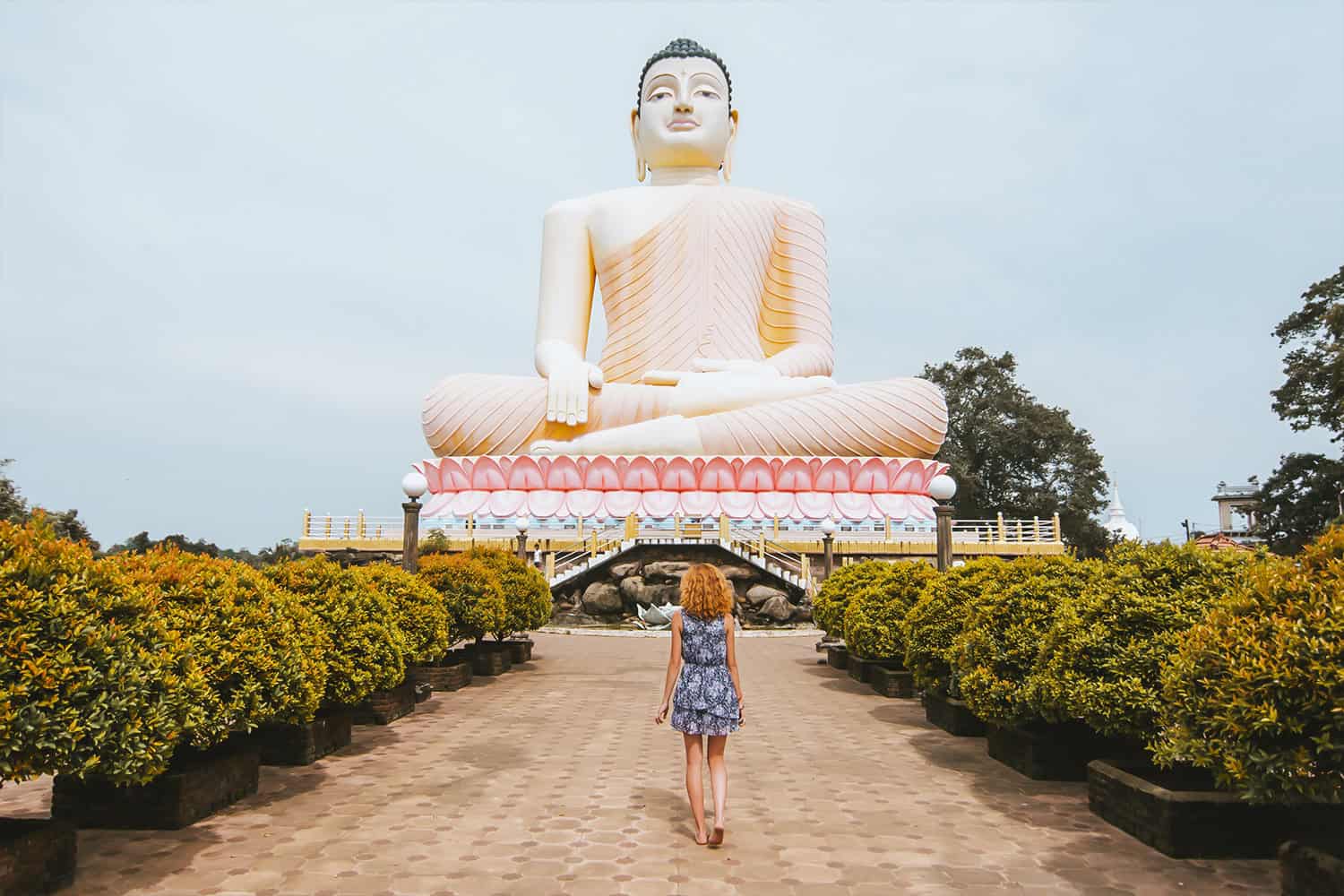Growing up in a Sri Lankan Buddhist family meant that, almost each school holiday, you got to go on family pilgrimages to Buddhist temples in different parts of the island. My childhood memories are filled with such long-winded yet delightful journeys; they were always looked forward to, because, well, who doesn’t love a road trip!
My father, with his deep interest in archaeology and Buddhism, would read up historical details of these temples, and tell us names of the kings who built this Buddha statue and that Buddhist stupa, and in which centuries. I believe that this practice instilled in me a love for history and an admiration for the artistic talents of my ancestors. It also made me understand how closely interrelated Sri Lanka’s past is with the history of Buddhism.
In this article, I traverse down memory lane and also take you through historical and, sometimes, literary, architectural and mythological detail related to Buddhist temples in Sri Lanka. From the world-renowned Anuradhapura and Polonnaruwa temples, to the relatively lesser known sacred locations of southern Mulgirigala and northern Nagadeepa temples, this article details several Buddhist temples in Sri Lanka. And, let’s begin at the Dambulla Cave Temple.
1. Dambulla cave temple: An art gallery in the caves
The Dambulla Rajamaha Viharaya is Sri Lanka’s largest and best-preserved cave temple. It is also a testament to the vibrant imaginations of ancient local painters and sculptors. This temple has five caves and, in the cool half-light of each, you will be able to witness intricate murals relevant to Buddhist history and culture. Most of these wall and ceiling paintings belong to the 18th century and are examples of Kandyan paintings.
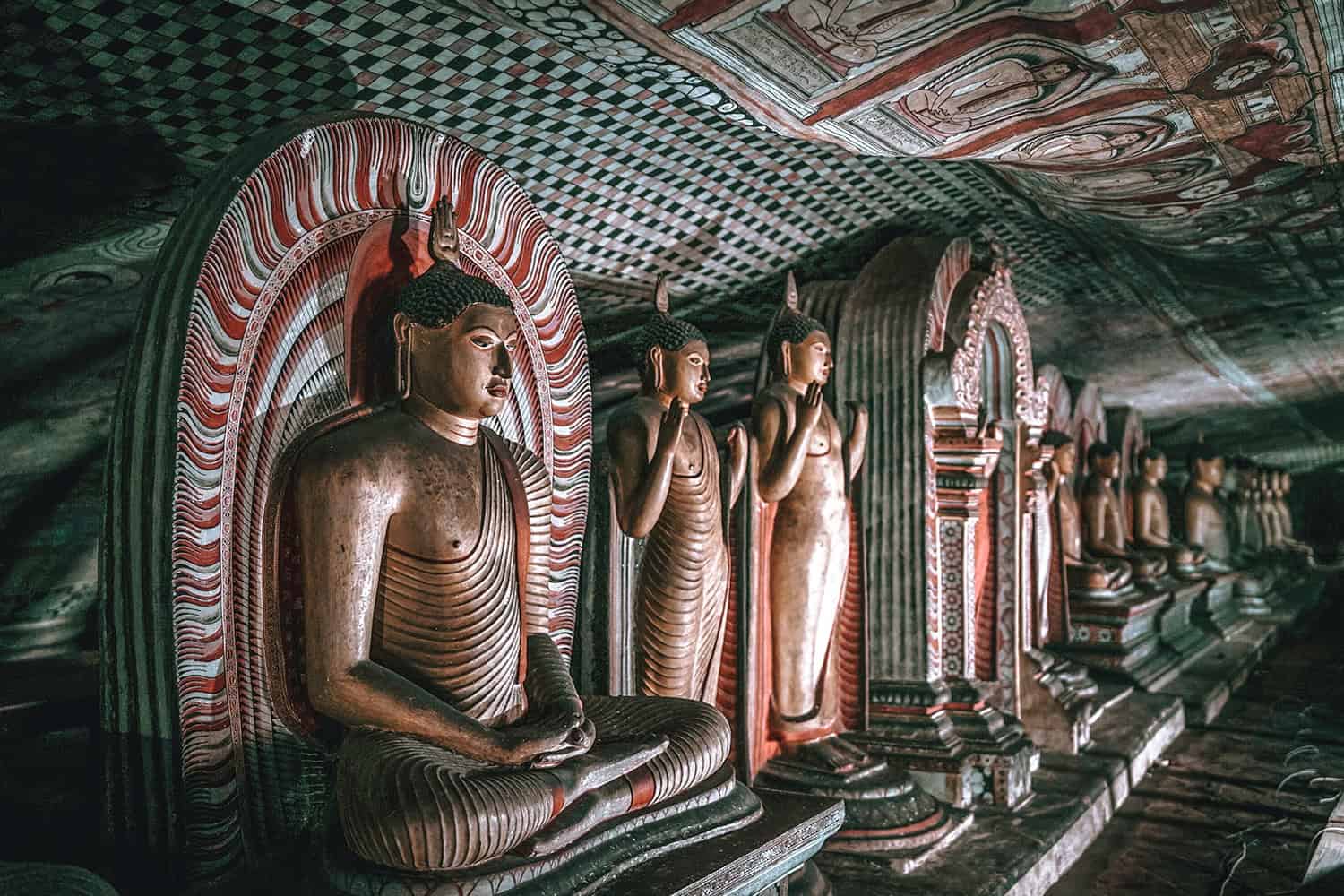
For me, the paintings are exquisite as they are colourful! They seem to shield and convert the hard rock surface into a giant, multi-hued canvas!
Collectively, the paintings cover a total area of over 2,100 square meters! Kindly bear in mind that this calculation does not take into account the various layers of paintings; buried beneath the Kandyan drawings that we see today are works of art that date back to the Anuradhapura and Polonnaruwa periods. In essence, the layers of colours and brush strokes in these caves reflect the artistic styles and traditions of different historical periods of Sri Lanka!
While the majority of the iconic Dambulla paintings are around 300 years old, this Buddhist temple has been in existence for 2,300 years! And, like many other famous Buddhist temples in Sri Lanka, the Dambulla temple has connections to Sri Lankan royalty; history chronicles show that King Vattagamini Abhaya (103-77 BC, better known as King Valagamba) lived in these caves for 15 years before successfully fighting South Indian invaders to reclaim his throne.
The entrance into the five-cave complex is via a memorable 18th-century colonnaded verandah. This takes you into the five caves of the Dambulla Temple: Devaraja Lena, Maharaja Lena, Maha Aluth Vihara, Paschima Vihara and Devana Aluth Vihara.
The first cave you would come across is the Devaraja Lena (Lena = cave). Among the many paintings in this cave is a depiction of the patron god of art and architecture, God Vishwakarma. I interpret this artwork as the painter’s sign of gratitude and homage towards the god that inspired him! There is also a reclining Buddha statue and a statue of Arahat Ananda, first cousin to Prince Siddhartha and the Buddha’s principle disciple.
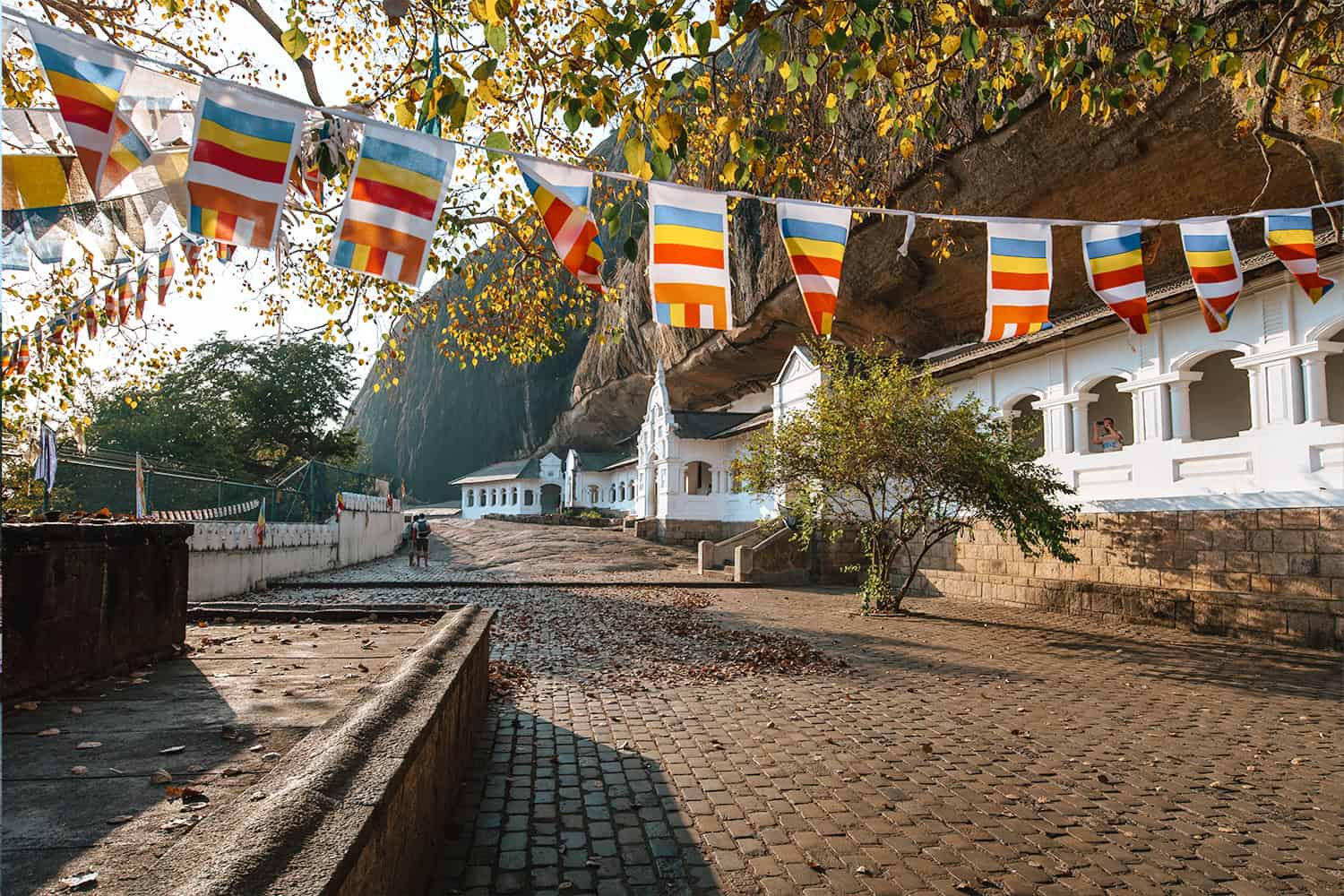
A Makara Thorana (Dragon Archway) stands at the entrance to the largest cave, the Maharaja Lena. This arch is an architectural feature found in ancient Buddhist temples in Sri Lanka and also in mainland Asia. The seated Buddha statue that you encounter as soon as you enter too is crowned with a Makara Thorana.
Apart from this Buddha statue, there are many other sculptural depictions of the Buddha in the seated, standing and reclining attitudes within the Maharaja cave. Like the Buddha statues, the exquisite Kandyan paintings in this cave pay homage to the Buddha: they portray events such as the birth of Prince Siddhartha and Him embracing an ordained life. Another mural depicts the moment Ascetic Gautama attained Buddhahood by defeating the Maaras (demons symbolizing rebirth, desire and death).
In addition, this cave shelters a statue of God Naatha (or Avalokitesvara) who is considered to be the next Enlightened One, or Maithree Buddha. A statue of God Saman, the patron god of Adam's Peak, too can be seen in the Maharaja Cave. Other statues memorialize Kings Valagamba and Nissankamalla from the Anuradhapura and Polonnaruwa kingdoms, respectively.
Decorated with a Dragon Arch entrance, the Maha Aluth Viharaya Cave is the second largest cave at Dambulla. Credited with the construction of this cave is King Sri Wickrama Rajasinghe (1798-1815), who was succeeded by Great Britain’s King George III.
King Rajasinghe’s cave has a painting that depicts an aerial view of Lake Anothaththa (or Anavatapta Vila). Similar to the Dragon Arch and the drawings of the Maaras, the painting of this lake is an allusion to Buddhist cosmology and mythology.
The Paschima Cave and the Devana Aluth Viharaya are two small caves located at the end of the colonnaded verandah. The former has a miniature stupa that is believed to enshrine the jewelry of one of King Valagamba’s wives, Queen Soma Devi. The fifth cave, which is the Devana Aluth Viharaya, shelters a statue of the Buddha in a reclining position.
The Dambulla Rajamaha Viharaya is a time capsule that contains artistic and literary evidence (in the form of a 12th century stone inscription) of the history of Sri Lanka and the spread of Buddhism in the island. That this significant Buddhist temple was awarded UNESCO status in 1991 is certainly not surprising!
2. The Kandy Dalada Maligawa: The home of the sacred tooth relic
The Temple of the Tooth is yet another UNESCO World Heritage Site visited by tourists and Buddhist pilgrims, local and international. Out of all the famous Buddhist temples in Sri Lanka, the Temple of the Tooth would be in the top five of a list of temples I have visited the most!
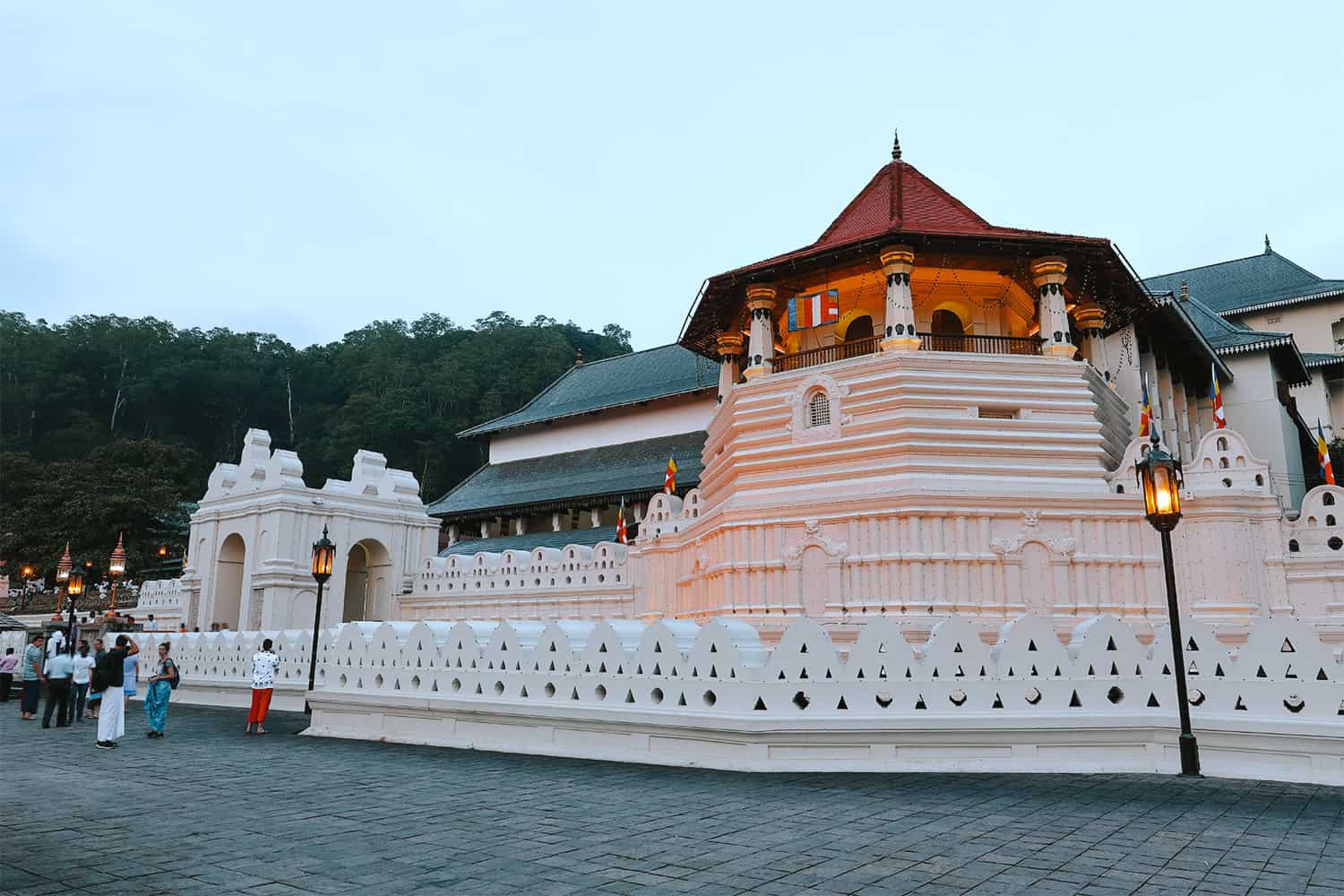
Located in the hilly district of Kandy, the Temple of the Tooth brings glory to the city of Kandy, as it is home to the revered sacred tooth of the Buddha. In the 4th century BC, the Sacred Tooth arrived in Sri Lanka, hidden in the hair updo of Indian Princess Hemamala. Until 1595, the relic was transferred from one safe location to another. Now, it sits within the Dalada Maligawa, and is considered to bless the whole island.
Although today many consider the Sacred Tooth to personify the Gautama Buddha, the significance of this relic is not merely religious in nature. In the past, the Tooth also determined who deserved the power to rule. Whoever had possession of the relic was suitable to be king. So, the Relic was a determiner of royalty and was given political importance.
For me, the most memorable feature of the Temple of the Tooth is the Paththirippuwa. (pathir = to watch, irippu = seated, in Tamil). Today, in English this architectural feature is known as the Octagonal Pavilion. Built in 1812 during the reign of King Sri Wickrama Rajasinghe, the Paththirippuwa has come to symbolize the Temple of the Tooth, as well as the entirety of the city of Kandy!
The Paththirippuwa was completed 3 years before the commencement of British rule in Kandy. This was from where Sri Lanka's final king (Sri Wickrama Rajasinghe) addressed his people and watched the Perahera. The inner chambers of this building were used as the King's Archive, and, later, as the office of the governor. Today, it is a library with ancient Buddhist dhamma books, accessible to the public.
Right next to the iconic Paththirippuwa is the main entrance to the temple building. This gateway is known in Sinhala as the Maha Wahalkada. The entrance has a flight of steps which begins with an ornamented moonstone or "sandakada pahana." The moonstone is an architectural feature of Buddhist temples and Sri Lankan historical buildings. The origins of the moonstone can be traced back to the Anuradhapura kingdom. Today, to enter the Temple of the Tooth, we walk across an artistic detail that is two millennia old! This, I believe, is awe-inspiring!
Along most of the length and width of the Dalada Maligawa temple is the Cloud Wall ("Walakulu Bamma" in Sinhala). This is yet another architectural characteristic that can be found in many famous Buddhist temples across the island.
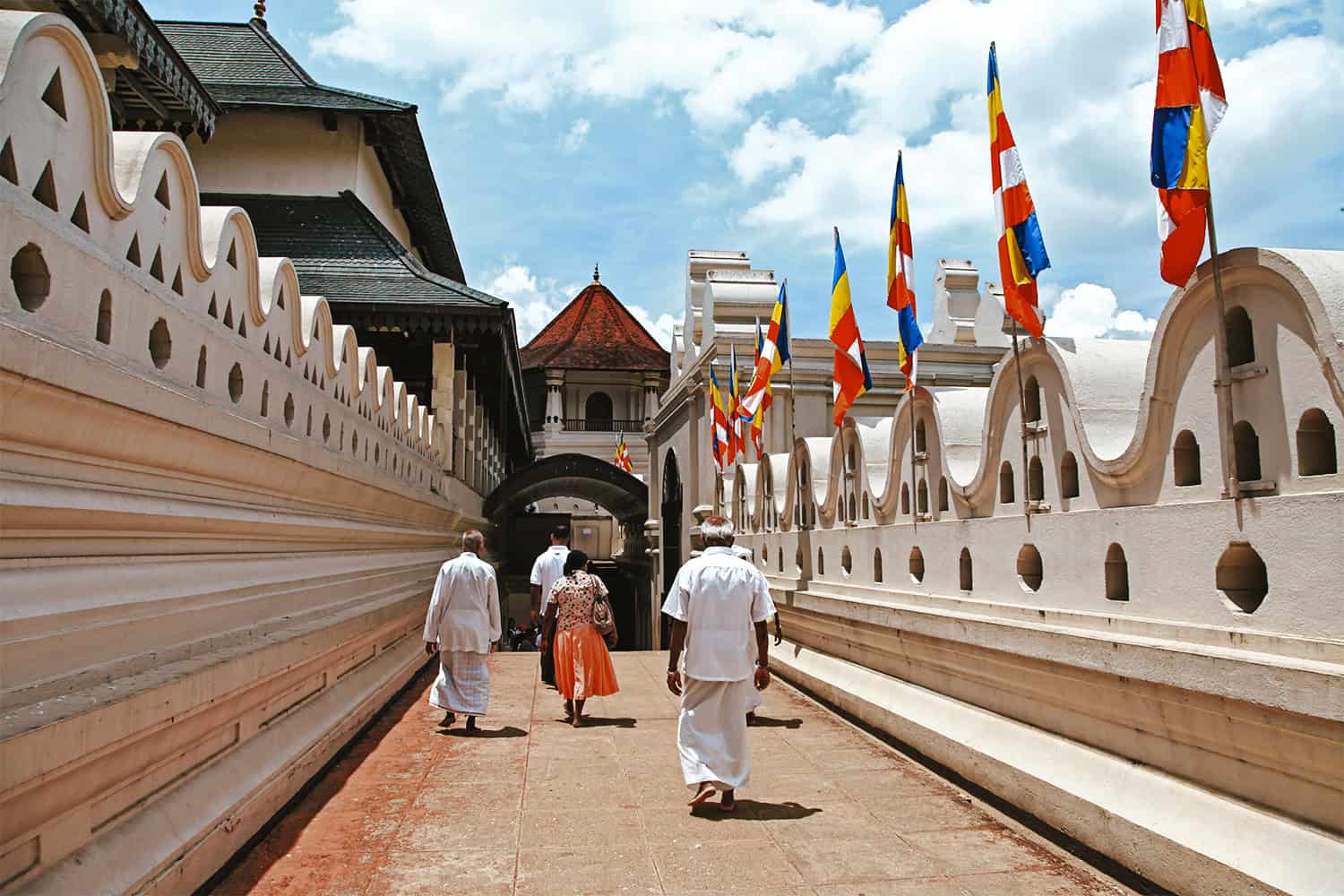
As you make your way further from the Main Entrance, you will walk through a colourful tunnel-shaped corridor which is an excellent display of the Kandyan artistic tradition. Known as the Ambarawa, this tunnel has a canopy of intricately painted lotuses and mandalas. On either side of the cool, paved pathway, you will witness the paintings of men dressed in traditional Kandyan attire, making their way towards the Sacred Tooth with offerings in their hands. The first time I passed through this corridor, I was struck by the resemblance that these vibrantly painted pilgrims bear to the story of the three Eastern kings who paid homage to Baby Jesus!
The Ambarawa corridor takes you to the "Wedasitina Maaligaawa" which is yet another intricately painted and carved stone-and-wooden structure that enshrines the sacred relic of the Buddha.
Right outside the "Wedasitina Maligawa" is the Drummers' Pavilion called the "Hewisi Mandapaya." Thrice every day, the Pavilion is filled with the reverberating Sri Lankan Hewisi drums and the melodies of a local wind instrument called the Horanawa. This music accompanies the daily rituals of the temple. These ritualistic sessions begin at 5.30 am, 9.30 am and 6.30 pm daily and are conducted for about half-an-hour. So, please do make sure to visit the Temple of the Tooth in time to witness this cultural practice!
What I personally find most endearing about the Dalada Maligawa is that it bears testimony to the confluence of Sri Lankan Buddhism with Hindu religious practices and beliefs. The premises of this iconic temple is also home to shrines devoted to Hindu gods and goddesses. Similarly, the world-renowned Kandy Dalada Perahera too pays tribute not only to the Sacred Tooth but also the Vishnu, Naatha, Katharagama and Paththini deities of Hindu origin who are worshiped by Buddhists.
I cannot do justice to the Dalada Maligawa in a blogpost carrying a few thousand words. So I will mention some of its main attractions and leave it to you inquisitive travelers to find out more! Make sure to visit the “Pallemala Viharaya” and “Uda Digge” close by the “Wedasitina Maligawa” and the iconic “Magul Maduwa” (or the King’s Audience Hall) in the large Dalada Maligawa premises.
The city of Kandy is full of light and life in July and August each year as its streets prep for the annual Dalada Perahera, a vivacious and melodious cultural event that parades the Sacred Tooth along the streets of Kandy. This cultural practice is ancient; it has been recorded in 5th century documents of the Anuradhapura historical era! Hundreds of glamorously-clad artistic performers including traditional Kandyan dancers, stilt walkers and drummers, parade the Kandy streets.
The Dalada procession is, without fail, watched by thousands of spectators who start occupying the pavements almost a day before the event begins. Local and foreign tourists sit on mats and newspapers in the noon sun awaiting the cool evening and the whip-crackers who head the Dalada Procession. I have watched the Perahera several times myself and was lucky to witness the hustle and bustle, and the sense of community and cooperation among the Perahera spectators along the Kandy pavements.
3. Mihintale Rajamaha Viharaya: The foremost landmark in Sri Lankan buddhist history
Among Buddhists of Sri Lanka, the Mihinthale temple is a much cherished religio-historical landmark located in the Anuradhapura district. Known in ancient times as Se Giriya or Chethiya Giriya (loosely translated as Mountain of Stupas), this ancient site is strewn with the ruins of an alms hall, a relic chamber, ponds, stone inscriptions, statues, columns, and, of course, Buddhist stupas.
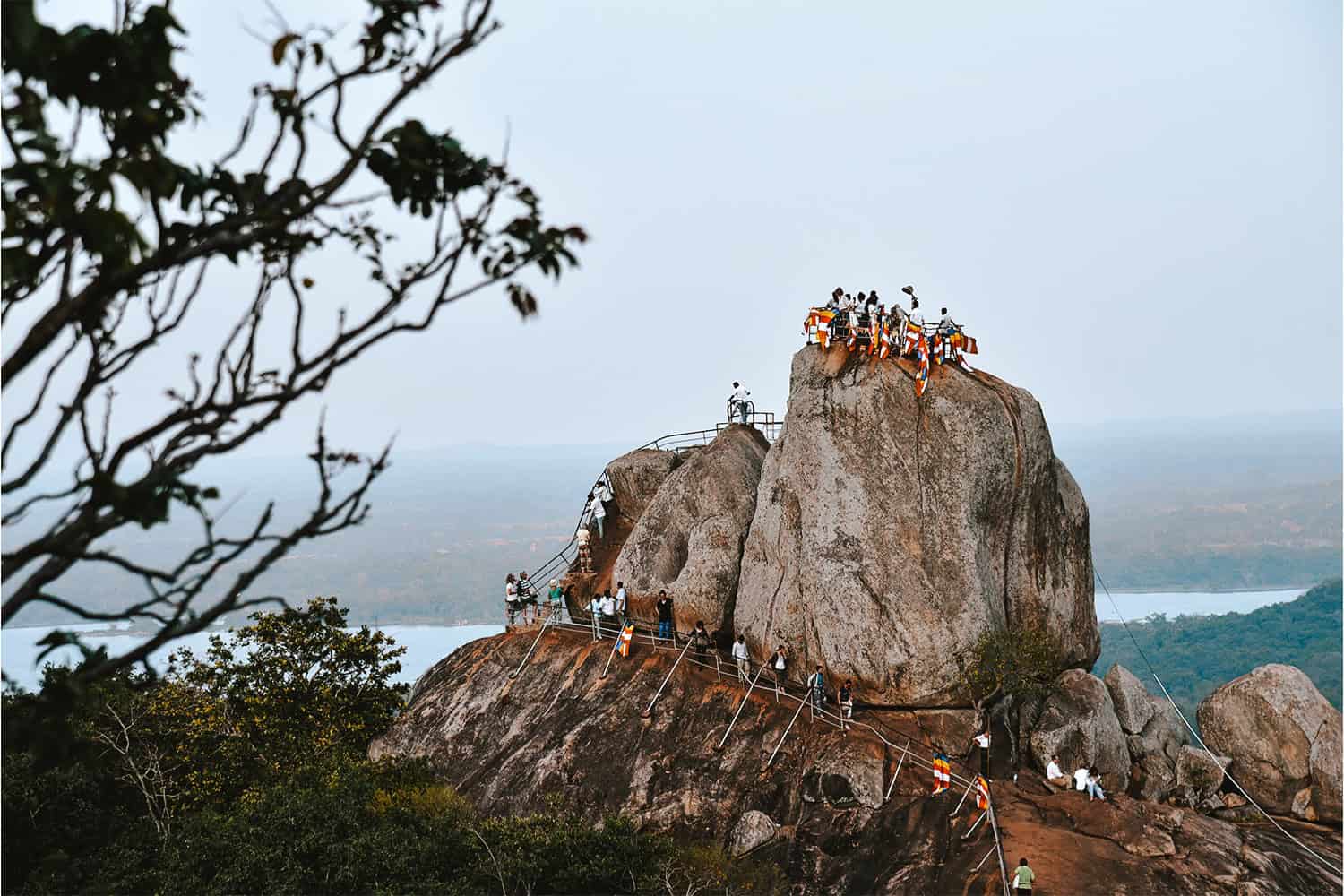
According to the chronicles of Sri Lankan history, the location that marks the inauguration of Buddhism in Sri Lanka is the iconic Aradhana Rock located within the temple premises. From atop this rock, Venerable Arahat Mahinda, the son of Indian emperor Asoka, preached Buddhism to Sri Lankan king Devanampiyatissa, after which the king embraced Buddhism. This event dates back to a June full moon day (Poson Poya) in the 3rd century BC, and is artistically recreated every Poson poya by Lankan Buddhist devotees. And, on a personal note, June being my birth month, the Mihintale temple and the historical incident associated with it hold a special place in my heart!
A visit to the sites within this olden monastery requires a trek; almost 3000 ancient stone steps take you from the base of this site up to the Aradhana Rock. These pathways are lined by Araliya trees, which were planted under the initiation of renowned Sri Lankan archaeologist, Prof. Senarath Paranavithana.
The arrival of Ven. Mahinda's entourage at Mihinthale is not a mere rumour; the encounter between Arahat Mahinda and Devanampiyatissa is recorded in the Mihinthale Rock Inscription which is dated 1st century AD. According to historians, this stone-carved document written in Old Sinhala mentions the names Mahinda, Ittiya, Badrasala and Uththiya - these names refer to Arahat Mahinda and other monks who accompanied him to Sri Lanka.
What memorializes Mihinthale in the minds of visitors to this temple is the Aradhana Rock. From the peak of this rock formation, visitors can enjoy a panoramic view of the surrounding flat terrain of the Anuradhapura district. The Aradhana Rock also affords pilgrims glimpses of a pearl white Buddha statue, and several stupas of varying sizes such as the Mihindu Seya, Sela Chaithya and Mihinthale Maha Seya.
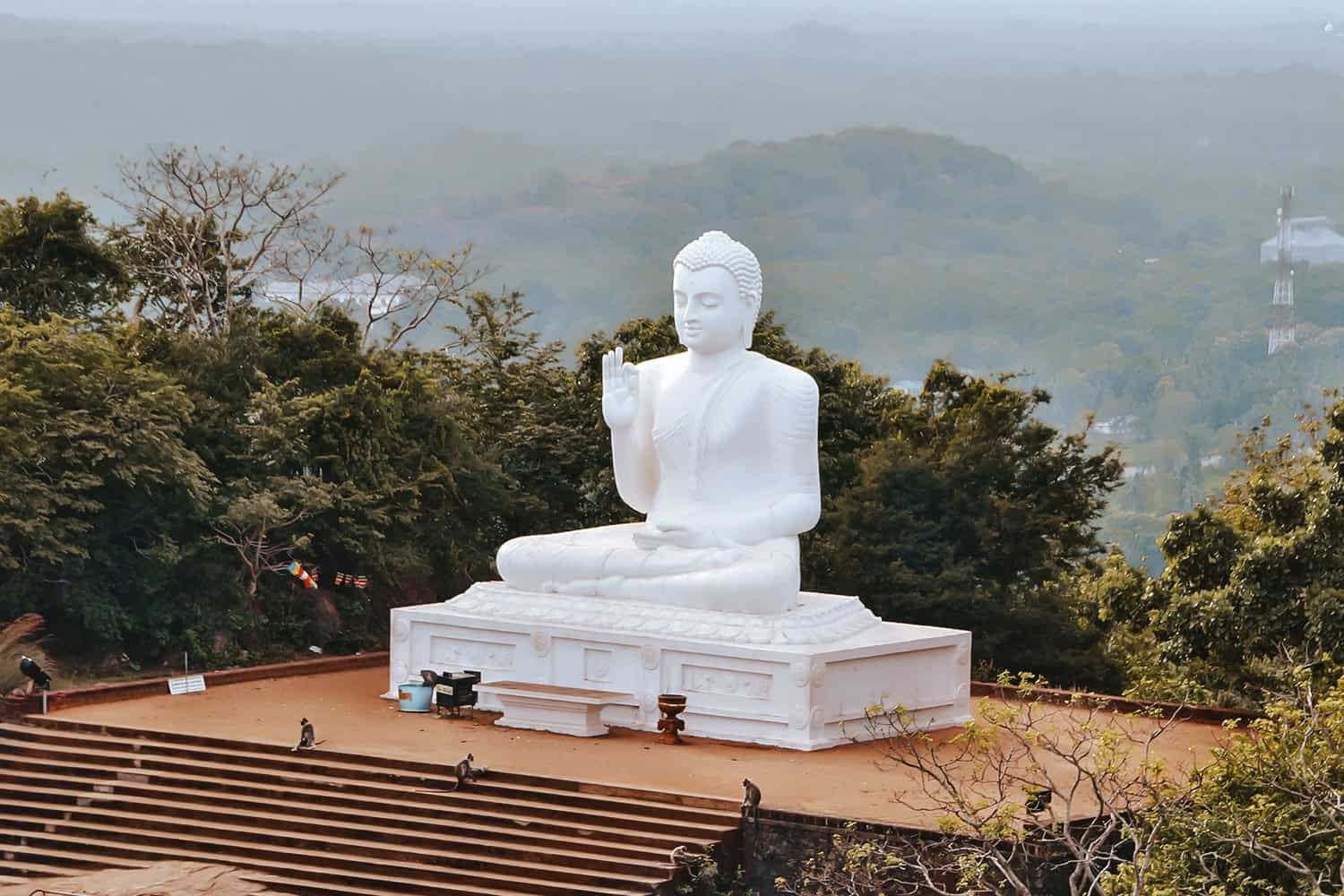
The views from the Mihinthale Maha Seya are spectacular; from its terrace, you can sight the Aradhana Rock as well as the Mihinthale Buddha statue. Also known as the Ambasthala Stupa, this snow white edifice is almost on the same elevation as the Aradhana Rock peak and was built in the 1st century AD during the reign of King Mahadatika-Mahanaga of Anuradhapura.
Neighbouring the Mihinthale Seya is the Mihindu Seya, a small brick stupa which was built between the 2nd and 3rd centuries to shelter the relics of Ven. Arahat Mahinda. These relics, and several miniature stupas that were found in this stupa, are no longer within the Mihindu Seya. They can be viewed in the relics chamber within the temple premises.
Circled by rows of carved stone columns is a white stupa much smaller than the Mihinthale Maha Seya. This is the Sela Chaithya believed to have been built by King Lajjithissa in the 1st century BC. This stupa as you know today is the product of various architectural additions done to it by kings from different eras who added a shelter above it, probably supported by the stone columns that survive to this day. A relatively recent addition to the Sela Chaithya vicinity is the golden statue of Ven. Arahat Mahinda looking towards the ancient stupa.
Other sites within the Mihinthale monastery premises include the ruins of an alms hall, meeting hall, a relic chamber, the Naaga pond and the Lion Pond.
The alms hall contains many historical artifacts that I personally find amazing. As was the case with the Sela Chaithya described above, the alms hall too has stone columns of various sizes that may have supported the roof of this construction. This site also contains large canoe-shaped stone vessels called bath oru and viyanjana oru. These are vessels used to place rice and curries that were offered to the Buddhist monks of the Mihinthale monastery.
4. Temples of the Anuradhapura kingdom: of three monastery complexes and eight sacred sites
A visit to Anuradhapura is a teleportation to the first kingdom of Sri Lanka! The ancient ruins of this city date back to the 4th century BC, and, today, the temples of Anuradhapura are visited by pilgrims and tourists from within and beyond Sri Lankan shores! Anuradhapura is also one of Sri Lanka’s many UNESCO World Heritage sites!
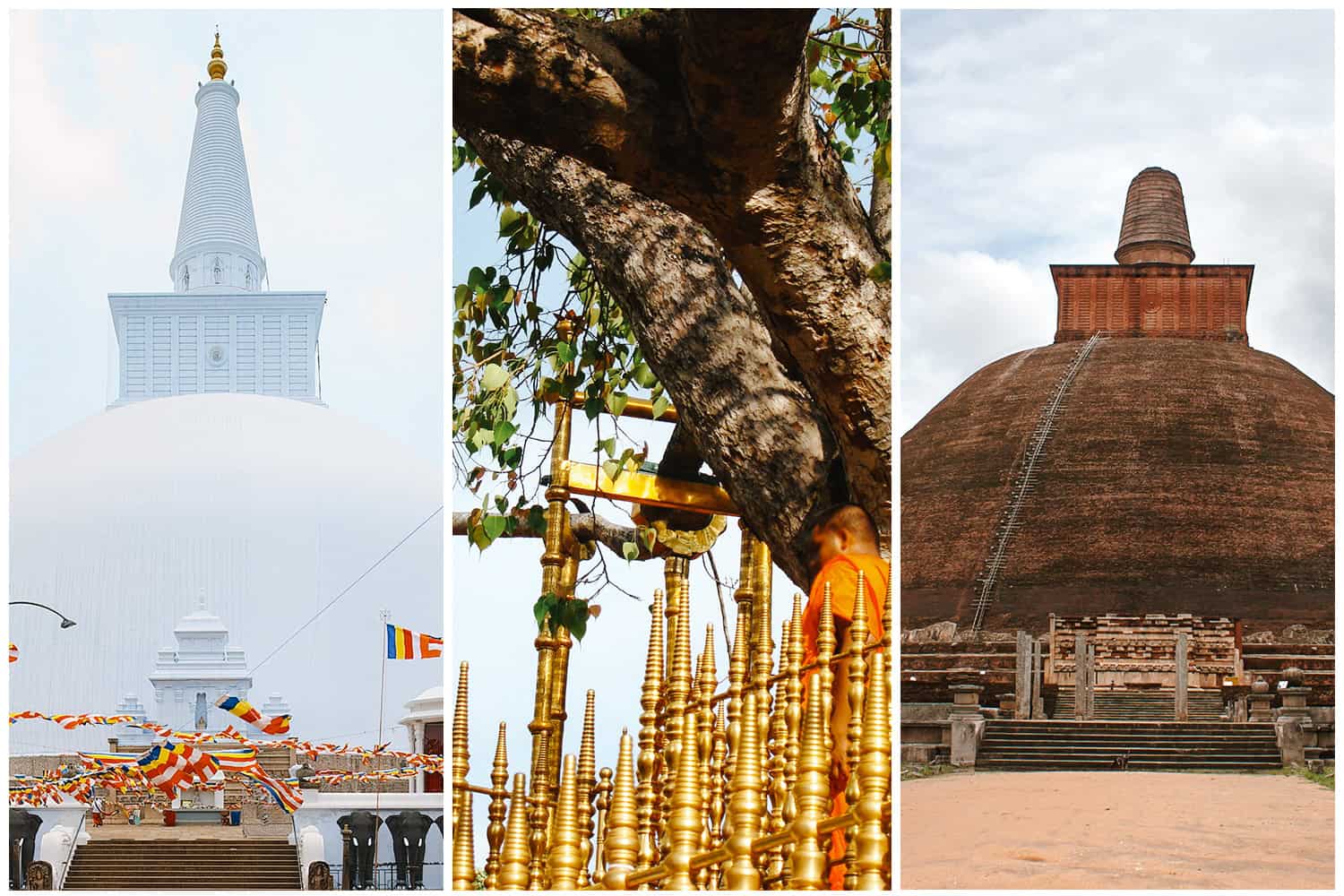
The Anuradhapura kingdom was a sprawling establishment. So, the ruins you see today at Anuradhapura are (unsurprisingly!) strewn across a wide area. A few words in an article about Sri Lankan Buddhist temples cannot do justice to the entirety of this majestic city, so I will limit this section to the Atamasthana or Eight Sacred Locations which are frequented by Buddhist pilgrims. Each of these locations belongs to one of the three Buddhist monastery complexes of Anuradhapura: Maha Vihara, Abhayagiriya and Jethawanaramaya.
The Maha Vihara monastery complex of Anuradhapura belongs to the Theravada Buddhist tradition. Established by King Devanampiyatissa in the 3rd century BC, this complex is home to five of the eight sacred places: Sri Maha Bodhiya, Ruwanwelisaya, Thuparamaya, Lovamahapaya, and Mirisawetiya.
The Jaya Sri Maha Bodhiya is a record holding bo-tree; it is the oldest tree in the world that has a written history! It is also believed to have been a sapling of the sacred tree which sheltered the ascetic Gautama as he attained Enlightenment! Having arrived in Sri Lanka in the 3rd century BC, the Sri Maha Bodhiya was planted in the Mahamevna Gardens in Anuradhapura by King Devanampiya.
For me, the rustling bo-leaves, the fragrance from the flowers on the altar and the incense sticks, and the pilgrims’ chanting of sacred verses all serve to soothe my mind.
The ambience at the Sri Maha Bodhiya is nothing short of holy!
Unlike the Sri Maha Bodhiya, the Ruwanwelisaya is a stupa, which is probably the most visited of all the eight sacred sites. Enshrined in this stupa is the largest collection of relics of the Buddha. Dating back to the 2nd century, the construction of Ruwanweliseya is attributed to King Dutugemunu, who is considered as a national hero as he unified the island.
Another stupa found in the Maha Vihara monastery complex is Thuparamaya. Compared to Ruwanwelisaya, Thuparamaya is smaller. But, it is famous as the first stupa to have been built in Sri Lanka. Located within the Mahamevna Park, this stupa was built by King Devanampiyatissa in the 3rd century BC. Thuparamaya is a bell-shaped stupa, surrounded by stone columns, which, in the past, may have supported a roofing structure.
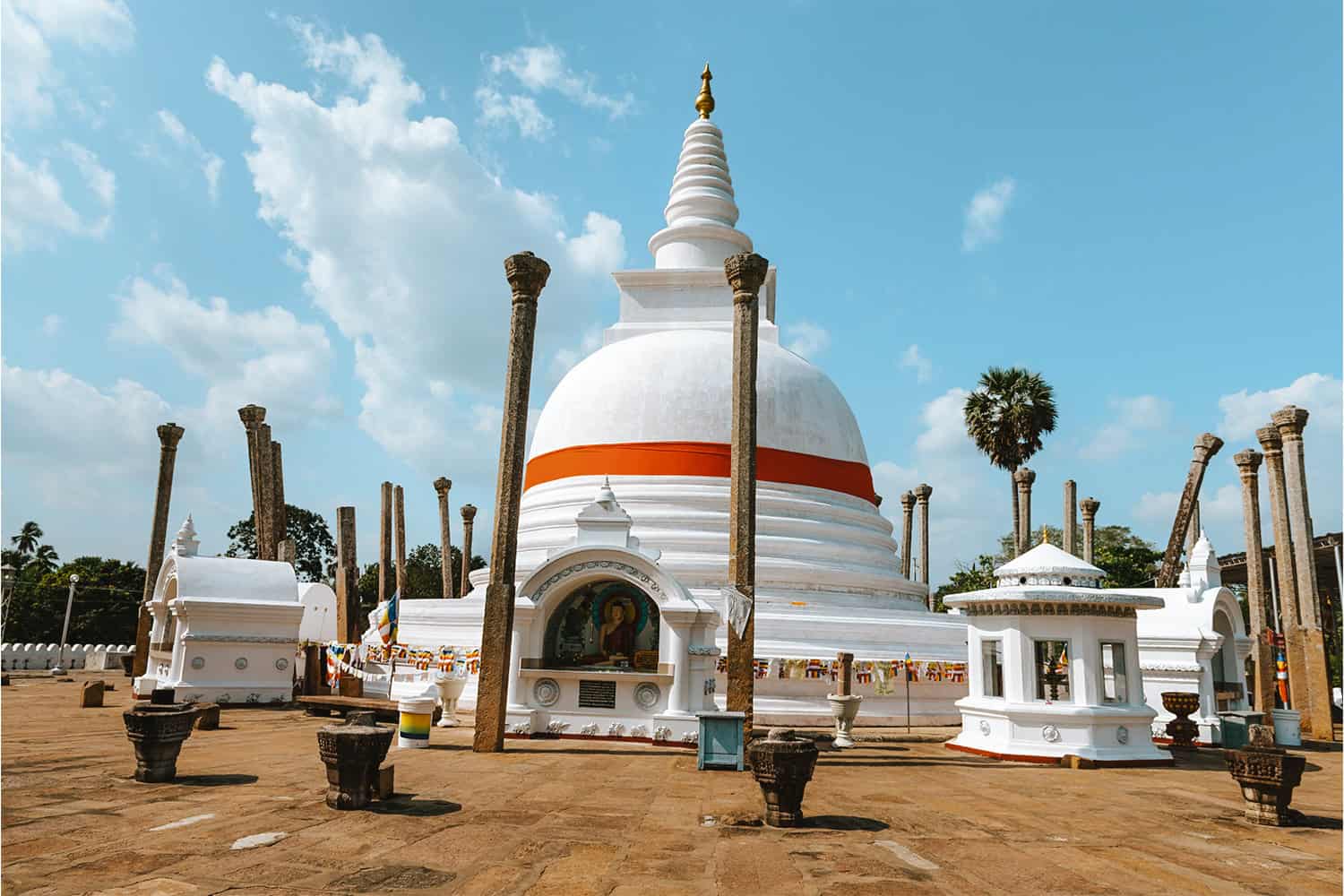
The Lovamahapaya was once a 9-storey edifice that has, over more than 2000 years, been reduced to the 1,600 columns that we see today. Also known as the Brazen Palace, the Lovamahapaya dates back to the reign of King Dutugemunu in the 2nd century BC. It once sheltered the monks’ quarters, an image house and a conference hall.
Like Lovamahapaya and Ruwanweliseya, the Mirisawetiya stupa was also built by King Dutugemunu. It actually predates Ruwanweliseya, and is shrouded in folklore; one of the stories that are associated with this is that it shelters King Dutugemunu’s royal scepter!
While the Maha Vihara monastery sheltered Theravada Buddhist monks, the Jethawanaramaya monastery was influenced by both Theravada and Mahayana traditions. This monastery was established by King Mahasena, who was a Mahayana follower himself. The Jethawanaramaya stupa is part of the Maha Vihara monastery complex. Dating back to the 3rd century AD, this dagaba enshrines a part of Lord Buddha’s clothing.
The third monastery complex is the Abhayagiriya monastery, which is home to two of the Eight Sacred Places - the Abhayagiriya and Lankaramaya stupas. This is a 200-hectare historical site, established by King Valagamba in the 2nd century BC. In the past, this monastery was home to around 5,000 Buddhist monks who lived and studied Mahayana and Theravada Buddhism here. In other words, Abhayagiriya was a world-famous Buddhist university in its heyday.
The Abhayagiriya monastery was also once home to the Buddha’s Sacred Tooth. The Kandy Perahera is believed to have originated in the prime of the Abhayagiriya monastery; the 5th-century Chinese monk Fa-Hsien, in his travel journal, writes of witnessing an annual festival at Abhayagiriya that honoured the Buddha’s Sacred Tooth. This event may have well been a predecessor of the Kandy Perahera.
Within this monastery complex, you can also see the 73m tall Abhayagiriya stupa built by King Valagamba. The same king also built the Lankaramaya stupa to honour one of his queens, Soma Devi, who, according to legend, sacrificed her life to save the king. Apart from these two stupas, which are the last two of the Eight Sacred Locations list, you will also be able to witness the Samadhi Buddha Statue, a moonstone, the Twin Ponds (Kuttan Pokuna) and the Elephant Pond (Ath Pokuna).
At the heart of Anuradhapura is the Inner City, also known as the Citadel. In this area is the Dalada Ge or the first Temple of the Tooth. As the Anuradhapura Kingdom succumbed to Chola invasions and the city of Polonnaruwa emerged as the country’s next capital, the Sacred Tooth was transported to the later city and supposedly deposited in the Vatadage in the Kingdom of Polonnaruwa.
5.Polonnaruwa temples: of a sacred relic stupa and stone and brick ruins
Established by King Vijayabahu I in the 11th century, the ancient Polonnaruwa Kingdom was Sri Lanka’s second capital after Anuradhapura. It is also my favourite out of all Lankan ancient kingdoms that I have visited. This is because, unlike some Anuradhapura monuments (e.g.: the Ruwanweliseya stupa), most historical sites in Polonnaruwa have been renovated to reflect the state they were found in in the 19th century i.e., with little to no modernization. Like its preceding kingdom, Polonnaruwa too is a UNESCO site.
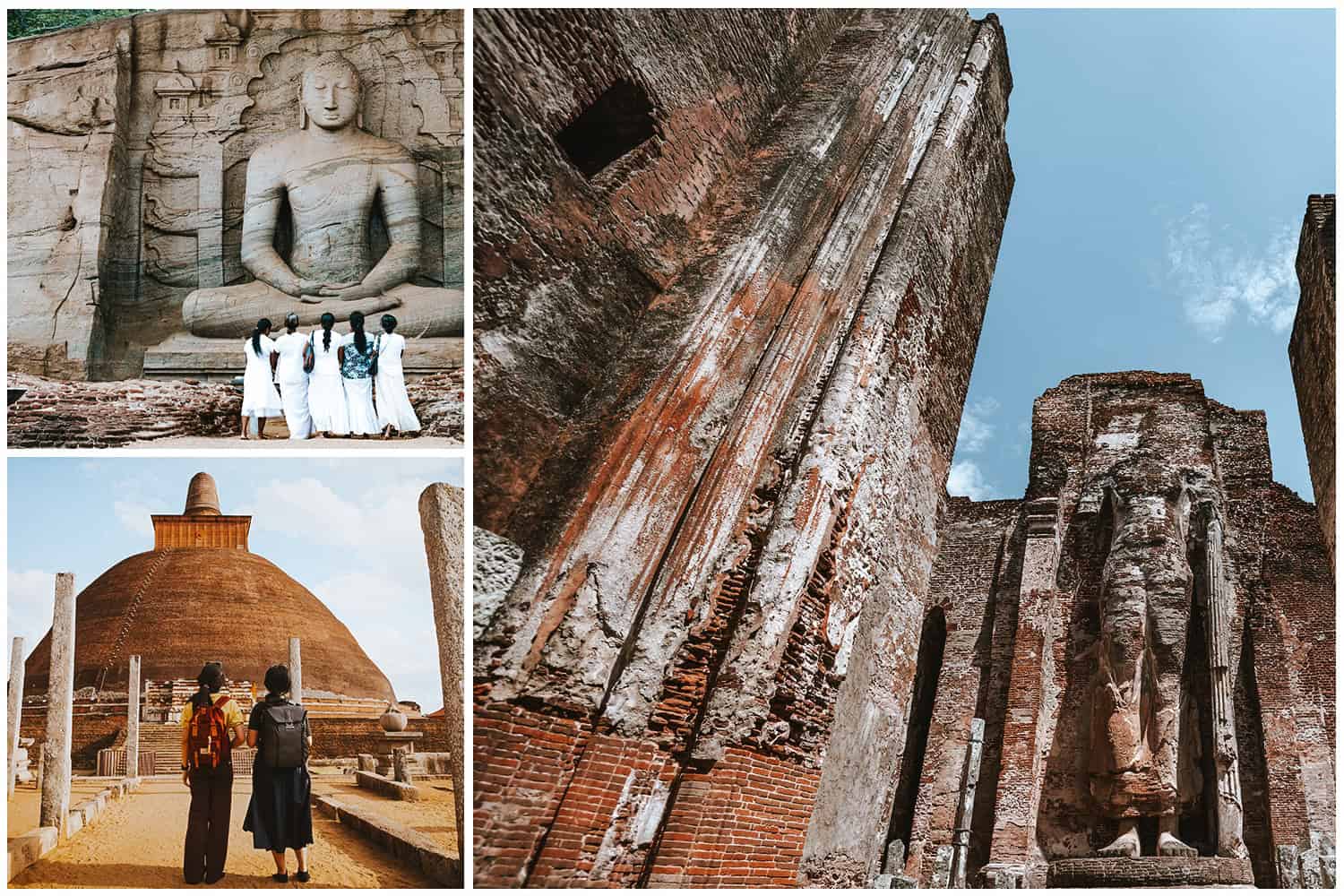
One of the most significant out of the Polonnaruwa ruins is the Polonnaruwa Vatadage, situated within the the Dalada Maluwa (AKA the Sacred Quadrangle). The Vatadage is a circular relic house, an architectural characteristic found in historical temples elsewhere in the country too, (for example, Thuparamaya and Lankaramaya of Anuradhapura too are Vatadageyas). However, the Polonnaruwa Vatadage is special as it is believed to have sheltered the Sacred Tooth in the days of yore!
The Polonnaruwa Vatadage has well-preserved stone carvings, including moonstones, guardstones and four Buddha statues that face the four cardinal directions. Behind the guardstones is yet another Sri Lankan architectural feature - the Makara (Dragon) - which begins with a spiral flower vine, originating in the mouth of a dragon. The dragon itself is a combination of parts of 7 other animals, including a lion’s foot, crocodile teeth, a monkey’s body and the feathers of a mythical bird named Gurulu. That an ancient stone sculptor chiseled these patterns (plus the floral ornamentation on a stone belt circling the Vatadage upper terrace) is admirable. That, many hundreds of years later, we witness and admire their imagination and skill, is awe-inspiring!
Within the Sacred Quadrangle, the Vatadage is accompanied by other sites like the Atadage, Hatadage, Nissanka Latha Mandapaya, Thuparama Gedige and the Sathmahal Prasadaya. In the Latha Mandapaya stand curvaceous stone columns carved to depict lotus stalks.
A stone slab bearing a verbal inscription stands erect in this quadrangle. Named the Velaikkara Inscription, better known as the Polonnaruwa Inscription, it dates back to the 12th century AD, and its script features both ancient Tamil and Sinhala letters. The contents of this written record is significant to the history of Buddhism in Sri Lanka; it contains a pledge made by South Indian Tamil mercenaries that they would protect the Shrine of the Tooth Relic and the surrounding shrines.
This agreement was arrived at between King Vijayabahu I and the Velaikkara community after the mercenaries rioted against the king, voicing their reluctance to fight against the Cholas, who the Velaikkaras considered to be their kinsmen. A stone slab carved with ancient script might not be particularly artistic to look at. Yet, I believe the contents of this inscription bear evidence to the political context at that time, and is therefore of importance not just in terms of Sri Lankan history, but also to the evolution of Sri Lankan Buddhism.
Like Anuradhapura, Polonnaruwa too is home to many stupas, of which Rankoth Vehera is the largest and most famous. This stupa stands tall in the Alahana Pirivena, which is the largest and most well-known monastery complex of Polonnaruwa. The stupa sports a brick exterior and is surrounded by the remnants of stone Buddha statues, and stone doorways and columns.
Another notable stupa within the Alahana monastery complex is the Kiri Vehera stupa, which is the second tallest stupa in Polonnaruwa. Both these stupas are believed to have been constructed by queens of King Parakramabahu I.
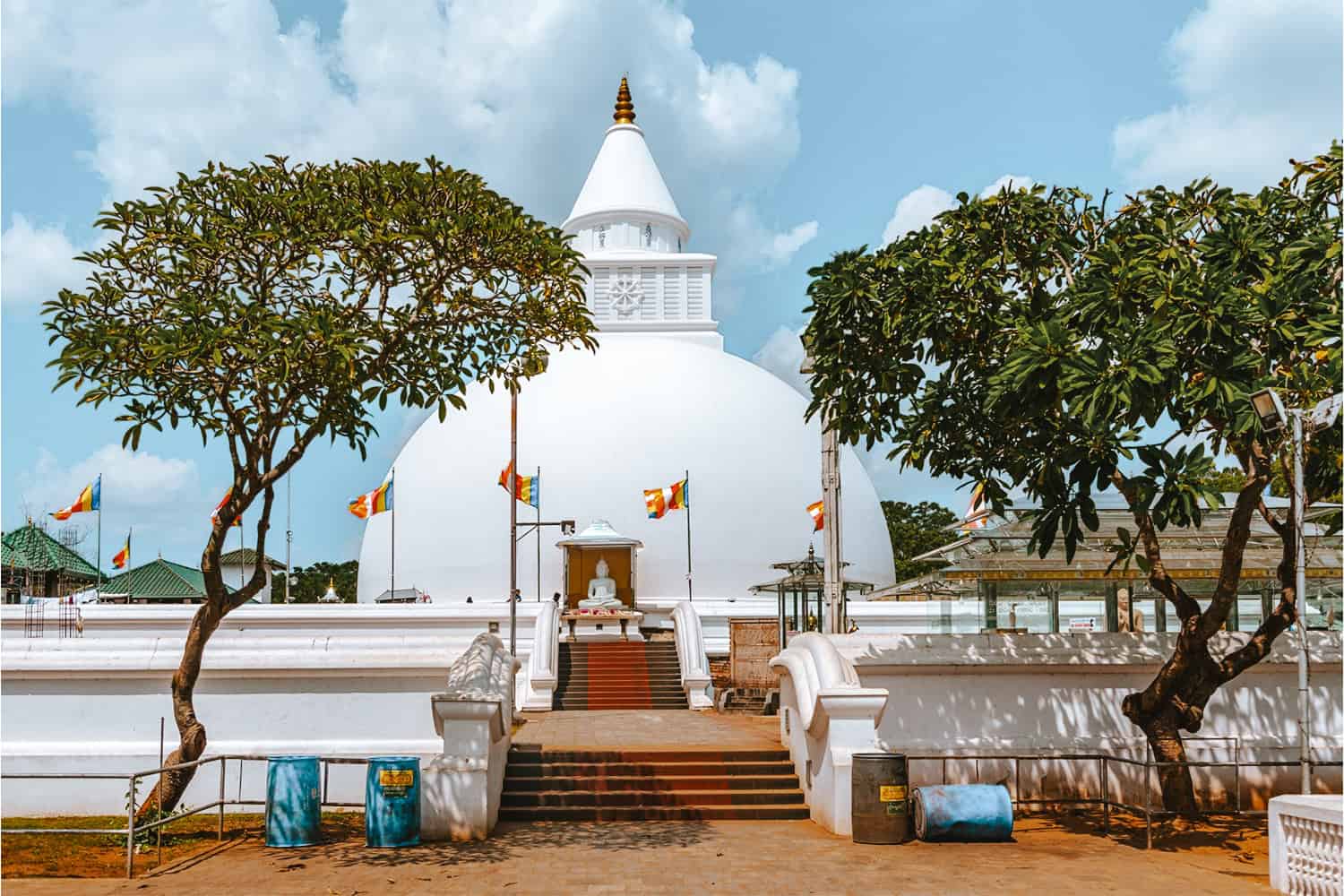
My personally favourite monuments at Polonnaruwa are the Lankathilaka Pilimage (Image House) and the Gal Vihara Buddha statues. The Lankathilaka Image House borders the Kiri Vehera stupa, and is a former 5-storey edifice, of which, today, the dilapidated tall brick walls and of the formerly 41 feet tall Buddha statue still manage to exude grandeur.
Unlike the dilapidated brick Buddha statue in the Lankathilaka Image House, the four statues at the Gal Vihara Temple are intact, as they are carved out of an expansive, live, granite rock. Formerly called Uththararamaya, meaning the northern monastery, this artistic marvel was created during King Parakramabahu I’s reign in the 12th century.
Out of the four Buddha statues at this temple, two depict a seated Buddha in meditation, while the third is a standing Buddha statue, with His arms crossed across his chest. This statue is one of a kind, as this particular hand positioning is unseen elsewhere, except in statues replicating the Gal Vihara standing Buddha. Such a replica can be seen at the Gangarama Seema Malaka temple in Colombo.
The fourth statue at Gal Vihara is the largest and is a reclining statue portraying the passing away of the Buddha.
On the Gal Vihara rock face is yet another stone carved record. It is believed that this inscription documents a code of conduct penned for Buddhist monks at a congregation of clergy and royalty at Gal Viharaya under the orders of King Parakramabahu I. According to historians, the inscription also holds evidence to the king expelling Buddhist monks convicted of misconduct at this very same gathering. So, the Gal Vihara is not only an artistic masterpiece but also contains a record of historical fact.
Having withstood the test of time and still memorializing a compassionate philosopher and enlightened human being, the Lankathilaka Image House and the Gal Vihara statues only serve to humble me at their feet. On a different note, you might have already seen both these locations in the 1980s Duran Duran “Save a Prayer” music video!
Apart from the key Buddhist temples described in this section, there are many more Buddhist monuments at Polonnaruwa worth visiting and exploring. Some of them are the Thivanka Image House which is yet another awe-inspiring work of art, and the Pabalu Vehera and Menik Vehera. In addition, this ancient city sports palace complexes, ancient Hindu temples, ruins of historic hospitals and a library, and ponds and reservoirs.
6. Gangaramaya and Seema Malakaya: The urban temples
In the heart of bustling Colombo is the Gangaramaya Buddhist temple. The serenity inside this temple contrasts with the activity along the adjacent Sri Jinarathana Road, and, on a clear, purple, Colombo evening, the Gangaramaya temple is a relaxing place to be at!
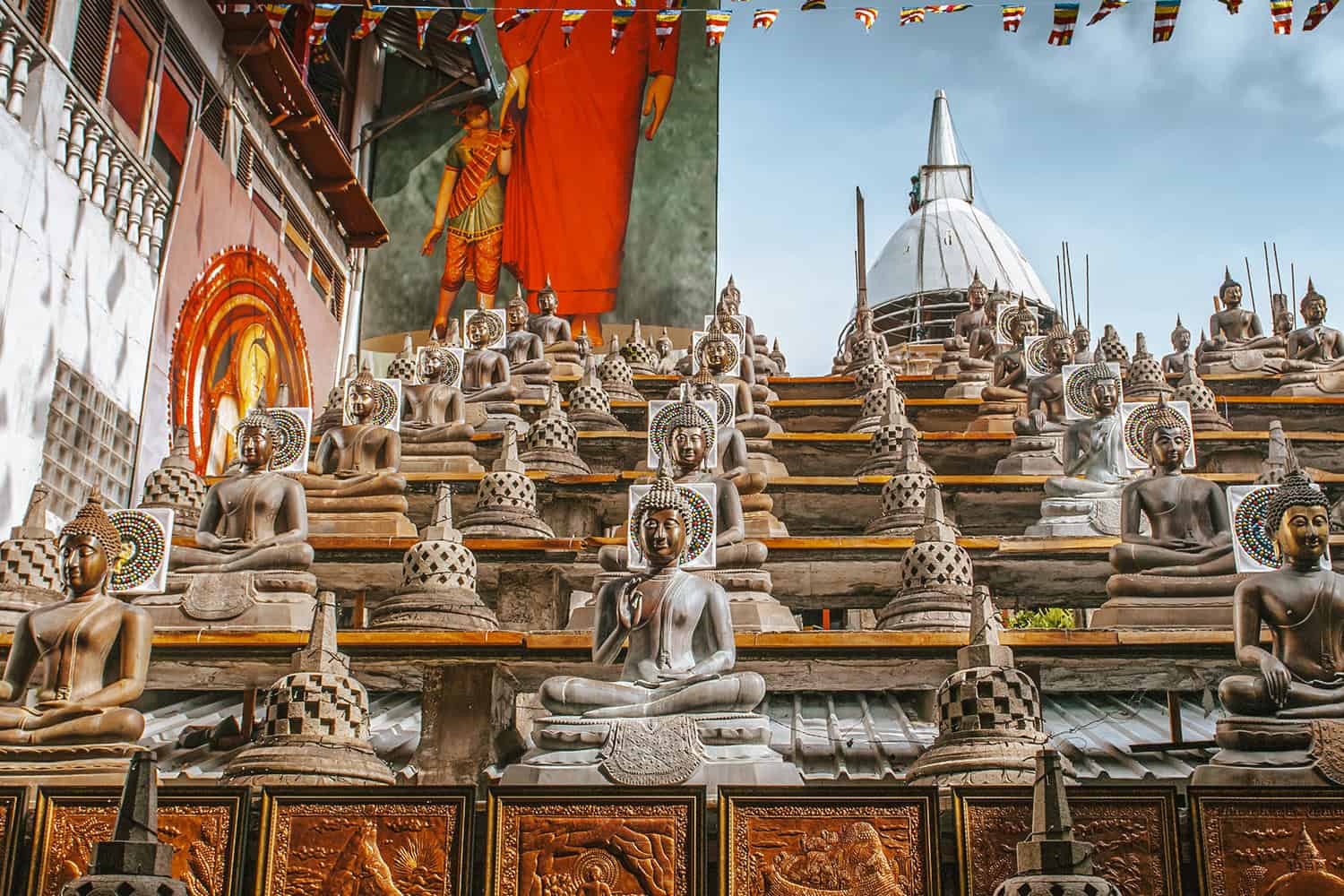
I especially like giving ears to the rustling of the Gangaramaya bo-leaves against the frequent car toot, crow caw, and devotees’ chantings of Buddhist verses! As an urban shrine located in Greater Colombo, Gangaramaya offers a mix of spirituality and a busy liveliness, which, I guess, is what makes this temple unique!
Gangaramaya is a confluence of Indian, Thai, Chinese and Sri Lankan Buddhist architectural features. Established in the late 19th century, Gangaramaya has a white-hued Buddhist stupa, a sprawling bo-tree with its vein-like roots visible to the visitor, and an image house with statues of the Buddha and his disciples, depicting various incidents of the Buddha’s life.
Gangaramaya is filled with hundreds of Buddha statues, many of which bear the features of Chinese and Thai Buddha statues. There is even a terraced, wooden slope lined with Buddha statues and stupas constructed to partially replicate the Indonesian Borobudur temple.
While at Gangaramaya, you can also witness photographs of several famous Buddhist paintings. In addition to the photo gallery, Gangaramaya has a library, a museum, a collection of vintage cars, and a taxidermy tusker!
Visitors to Sri Lanka in February can immerse themselves in the cultural experience of the Gangaramaya Navam Perahera which dates back to 1979. It celebrates the Navam Poya Day, (in other words, the February full moon day). This procession includes an assortment of elephants, flutists, fire and sword dancers, stilt walkers, whip crackers, and drummers. It also features different Sri Lankan dance styles. Unlike other similar processions in Sri Lanka, the Gangaramaya Navam perahera also includes a procession of Buddhist monks.
As all Buddhists worldwide reminisce and honour the birth, enlightenment and passing away of the Lord Buddha on the Vesak full moon poya day, the Gangaramaya temple too follows suit by organizing the ‘Buddha Rashmi Pooja.’ This event is held in May which, in Sinhala, is the month of Vesak.
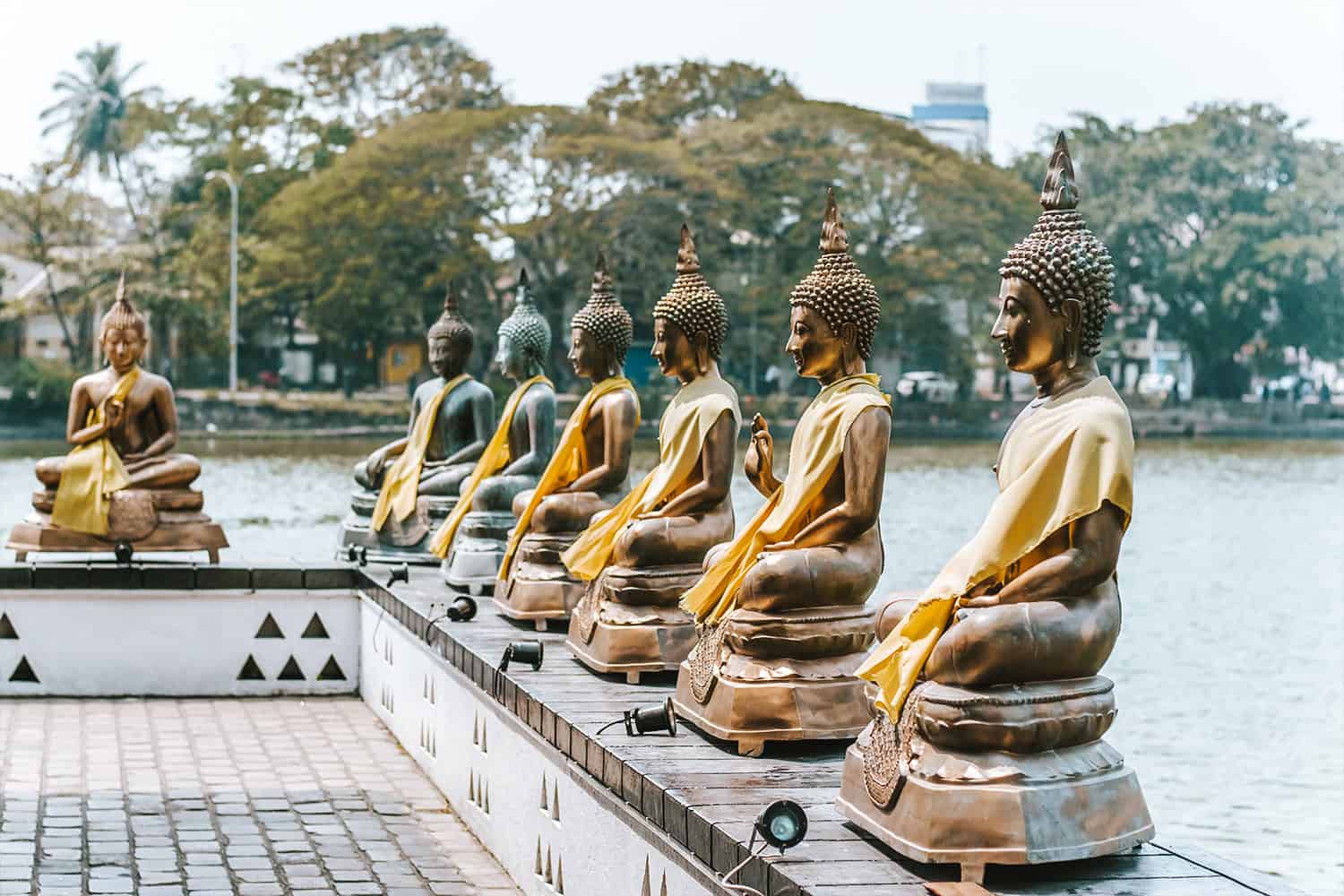
A short walk away from the Gangaramaya temple brings you to the Seema Malaka Shrine, an extension of the former, located right in the middle of the Beira Lake. The Seema Malakaya too, as I feel, is best visited in the evenings or at night, when the lights from the surrounding buildings are reflected in the Beira waters!
And, like most Buddhist temples in Sri Lanka, the Seema Malakaya too incorporates statues of Hindu deities (for example, Lord Ganesha) into its collections of statues. This is in addition to the numerous Buddha statues in various postures featuring a number of mudras (hand positions). These statues are of South East Asian and Sri Lankan tradition and most of them line the edges of this temple, gazing towards the buildings on the Colombo skyline.
The temple also has a Bo-tree, a white stupa, a moonstone, and a stone replica of the Buddha’s footprint, named the Pada Pagoda.
Not only does the Seema Malakaya feature both Buddhist and Hindu deities, it is also famous as a Buddhist temple whose construction was funded by a Sri Lankan Muslim businessman! So, it is safe to say that this temple reflects Sri Lankan religious as well as ethnic diversity and unity.
7. Mulgirigala Rajamaha Vihara: The cave temple of the south
The Mulgirigala Rajamaha Viharaya is yet another cave temple complex in Sri Lanka. Due to its close resemblance to the Dambulla Cave Temple and its location in the southern province, I personally think of Mulgirigala as the Dambulla Cave Temple of the south!
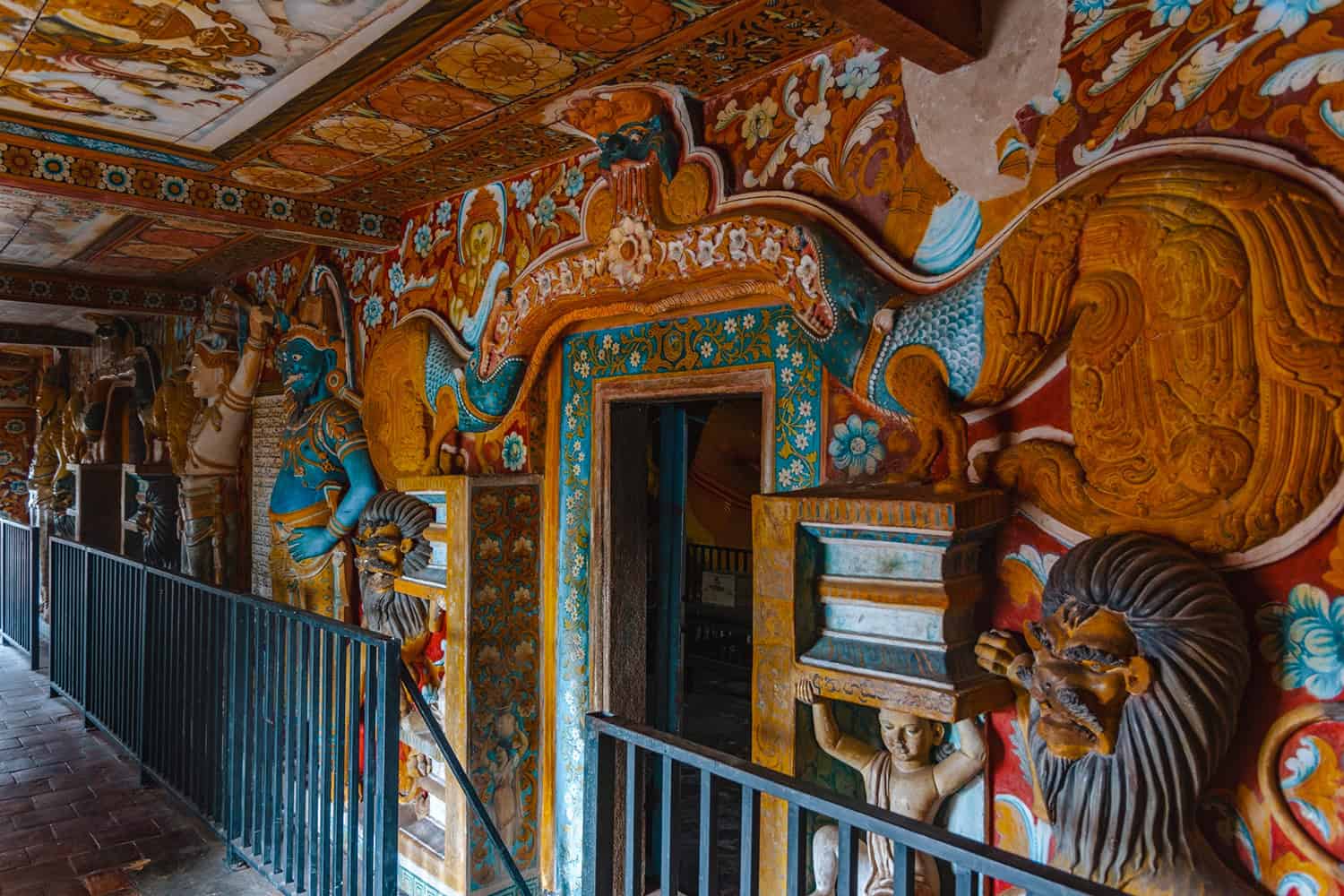
The Mulgirigala Temple dates back to the reign of King Devanampiyatissa in the 2nd century BC. Legend has it that this temple began with the planting of a bo-tree, after which the rock caves in the Mulgirigala area came to be occupied by both ordained and lay individuals engaged in a meditative and spiritual lifestyle.
Today, the terraced temple compound is scattered with eleven stone caves. Seven of them are adorned with ancient Buddha statues; and, similar to the Dambulla Cave Temple, the coats of colourful paintings at Mulgirigala represent different historical periods of Sri Lanka. The oldest paintings here belong to the Anuradhapura (3rd century BC - 11th century AD) and Polonnaruwa (11th -13th century AD) eras. The more recent murals belong to the Kandyan period (16th - 19th century AD).
On your hike up the approximately 670 foot tall Mulgirigala Rock, the first terrace you will arrive at is the Paatha Maluwa (Lower Terrace). On this terrace, there are two caves namely the Rajamaha Na Len Viharaya and the Paduma Rahath Temple. They are adorned with reclining Buddha statues, a decorated miniature stupa, portraits of various Buddhist and Hindu gods, and paintings depicting Jathaka stories, which are narratives of previous lives lived by the Lord Buddha.
My personal favourite historical artifacts at Mulgirigala Temple are the rock inscriptions found in the temple premises. You come across one of them, the Mulgirigala Rock Inscription, further along the way from the Lower Terrace, before reaching the second terrace named Bodhi Maluwa or the Terrace of the Bo-tree. Composed in Brahmi script representing Old Sinhala, this stone-carved record memorializes two individuals called Hidila and Padapagana. According to the English translation provided by the Department of Archaeology near the rock inscription, Hidila and Padapagana were "freed from compulsory service in the monastery." Although the context of this "compulsory service" is not known, it is amazing that these Old Sinhala words carved on the rock face memorializes two people from either the 6th or 7th centuries AD and makes their names known to us in the 21st century!
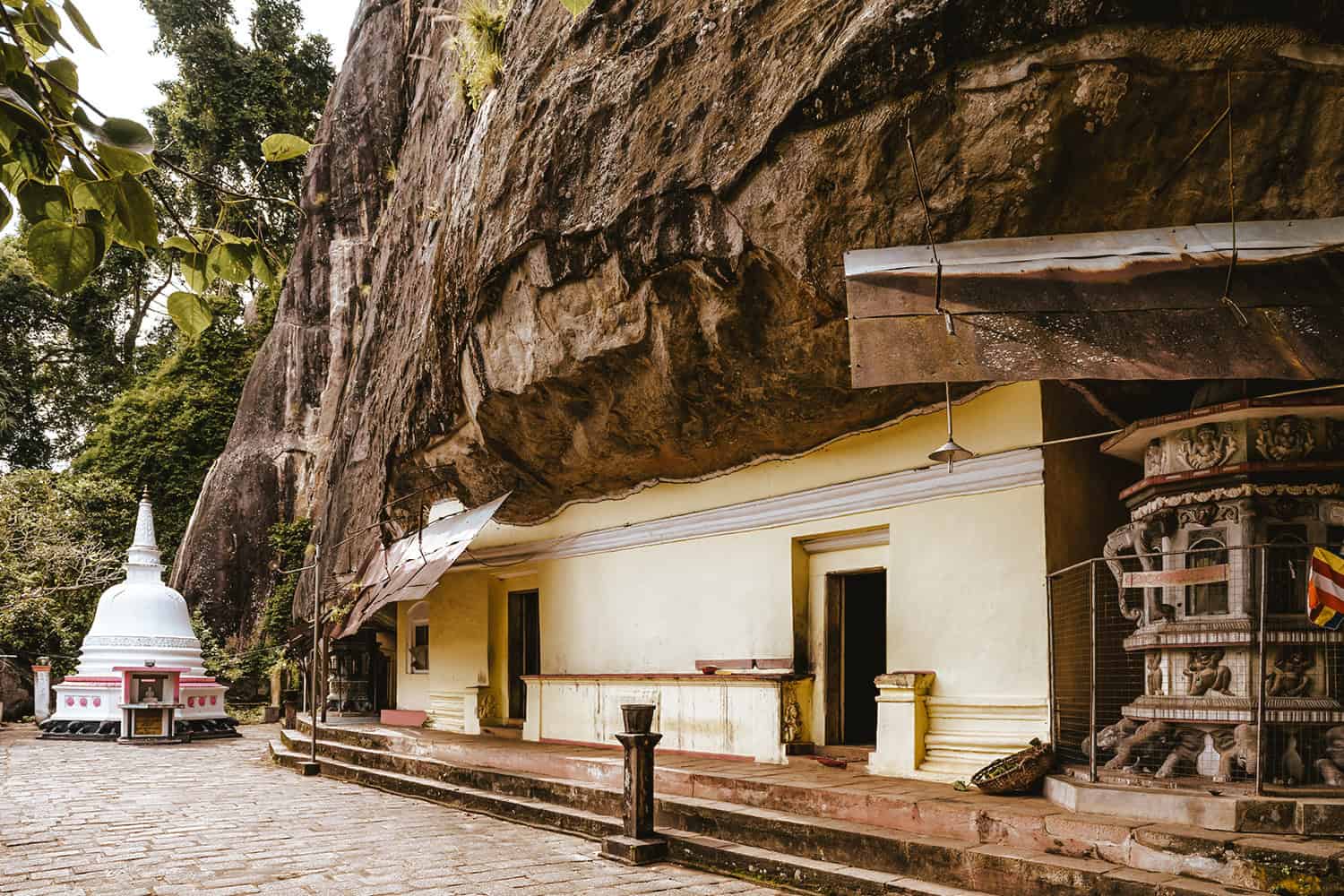
The Bo-tree Terrace is home to two caves which include paintings and Buddha statues. Among them is a representation of the Buddha flanked by statues of two of Buddha's disciples, Venerables Sariputta and Mogallana. Out of the many paintings, probably the most memorable one is the depiction of the birth of Prince Siddhartha.
On the third terrace, which is the Rajamaha Vihara Maluwa, are four cave temples which are home to exquisite wood carvings apart from murals and statues! The main stone staircase ends at the Wahalkada, or an entrance with a frontispiece, that leads you to the Parana Viharaya, or Old Temple. This is the oldest of the four caves on this terrace. The Aluth Viharaya (New Temple), Naaga Viharaya (Cobra Temple) and the Parinirvana Viharaya are the remaining caves on this terrace.
On the fourth terrace is the temple's renowned bo-tree which is believed to have been a sapling of the sacred Shri Maha Bodhiya in Anuradhapura. In other words, both the Shri Maha Bodhiya and the bo-tree at Mulgirigala are considered to be descendents of the tree under which Gautama Buddha attained Enlightenment.
On the fifth and last terrace, known as the Chethiya Terrace (Chaithya Maluwa), is a stupa sheltering relics of the Buddha. This terrace also provides a panoramic view of the surrounding; it is an ideal location to rest a while, enjoying the landscape and the welcome breeze!
8. The Kalutara Temple: The pearl on the western coast
Overlooking the Kalu River meeting the vast Indian Ocean, the Kalutara Temple is located 40 km away from Colombo along the Galle (A2) Road. This temple's pearl white stupa is as majestic as it is memorable; this 185 ft tall structure has come to symbolize the entire Kalutara district and is a landmark to look out for if you ever travel to southern Sri Lanka from Colombo, along the Colombo-Galle road or the southern coastal railway line.
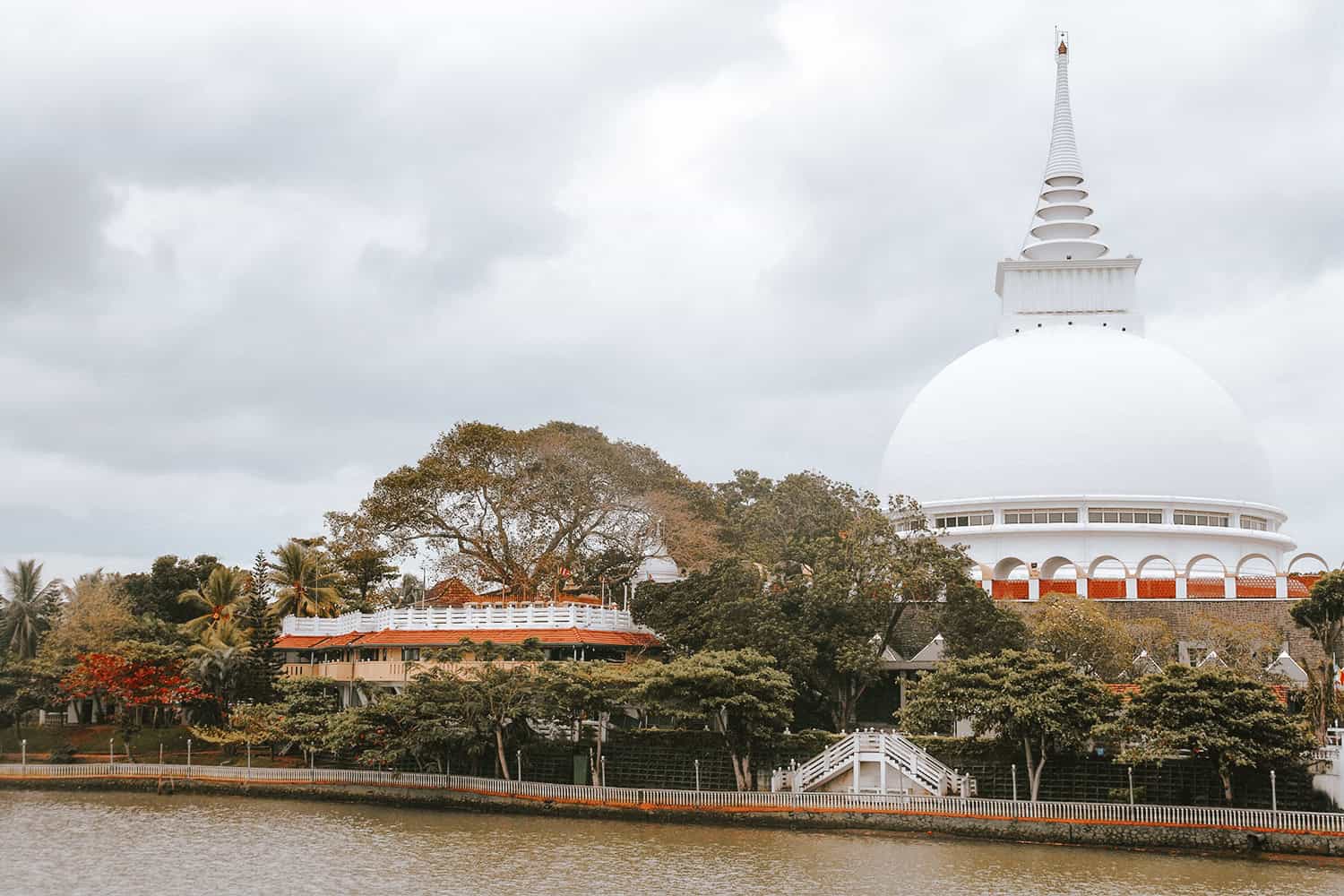
Most of my childhood family trips to the island’s south took me past the Kalutara temple and, each time we crossed the Kalutara bridge, we would make a brief stop to deposit coins in the collection boxes, and receive blessings! So, this temple will always be the sacred site that blessed my journeys down south!
The Kalutara Temple is intersected by the bustling Galle Road. The iconic Kalutara stupa is located on the Ihala Maluwa or the Upper Terrace of the temple. This section of the temple is connected to the Lower (Pahala) Maluwa via a subway. So, on your visit to the Kalutara Temple, make sure that you take this subway; if not, you will have experienced only half of what this picturesque and historic site offers!
Despite the busy neighboring main road, the temple itself is serene. I especially prefer visiting the stupa, which is one the first hollow Buddhist chaityas in Sri Lanka and in the world! Out of all the temples described in this article, the Kalutara Chaithya is the only one which allows you access into the stupa. In the inner chamber of this stupa, devotees recite holy verses which echo off the white, curved walls of the stupa! This seems to fill the space with words and thoughts of peace, and is one of my favourite experiences at the Kalutara temple!
Inside the massive chaithya is a miniature stupa surrounded by seated Buddha statues and flower altars. Along the walls of chaithya's inner chamber are illustrations of an assortment of Jathaka Tales, or stories of the Buddha's past lives.
A Bo-tree is a necessary feature of Buddhist temples in Sri Lanka, and, in the Kalutara temple, you can sit in the shade of several of these sacred fig trees. And, all of them are steeped in history. For instance, it is believed that, in 1042 AD, a king named Vikramapandya planted a Bo sapling here while fleeing from Indian Cholas who had invaded parts of northern Sri Lanka. And the tree is, today, on the Lower Terrace of the temple.
On the same terrace is yet another Bo-tree which has been named the Ananda Bodhiya It was planted in the 1960s by Sir Cyril De Zoysa, a local lawyer and philanthropist. This tree is a sapling of the Ananda Bodhi in the Indian Jetawana monastery. The Kalutara Ananda Bodhiya, along with another Bo-tree in the Upper Terrace, are thought to have originated from the Bo-tree under which the ascetic Gautama attained Buddhahood. So, unsurprisingly, the Bo-trees in the Kalutara Temple are revered and respected by local and foreign Buddhist pilgrims alike!
It is believed that the history of the Kalutara Temple runs back more than 2000 years, and, over the centuries, it has faced many threats of destruction! The Bo-tree on the Upper Terrace (which is thought to be a sapling of the tree under which the Ascetic Gautama attained Enlightenment) was almost cut down to make way for the British railway line during colonial times. The destruction of the tree was brought to a halt by protests led by an individual named Sandanayake. Colonial rulers also declared the bo-trees off limits to devotees. Today, in the temple premises there stands a renovated colonial building that once housed European administrative offices. So, the Kalutara temple is layered with both Buddhist and historical significance! And this is one of the many characteristics that it shares with the Nagadeepa Temple in northern Sri Lanka!
9. Nagadeepa Rajamaha Viharaya: A jewel in Sri Lanka’s crown
If the Jaffna Peninsula is Sri Lanka's crown, the Nagadeepa Temple is one of its jewels! Located on the Nainativu island, this Buddhist temple, along with the Nagapooshani Amman Hindu temple, casts its holy gaze across the neighboring Pungudutivu island towards the mainland of Sri Lanka.
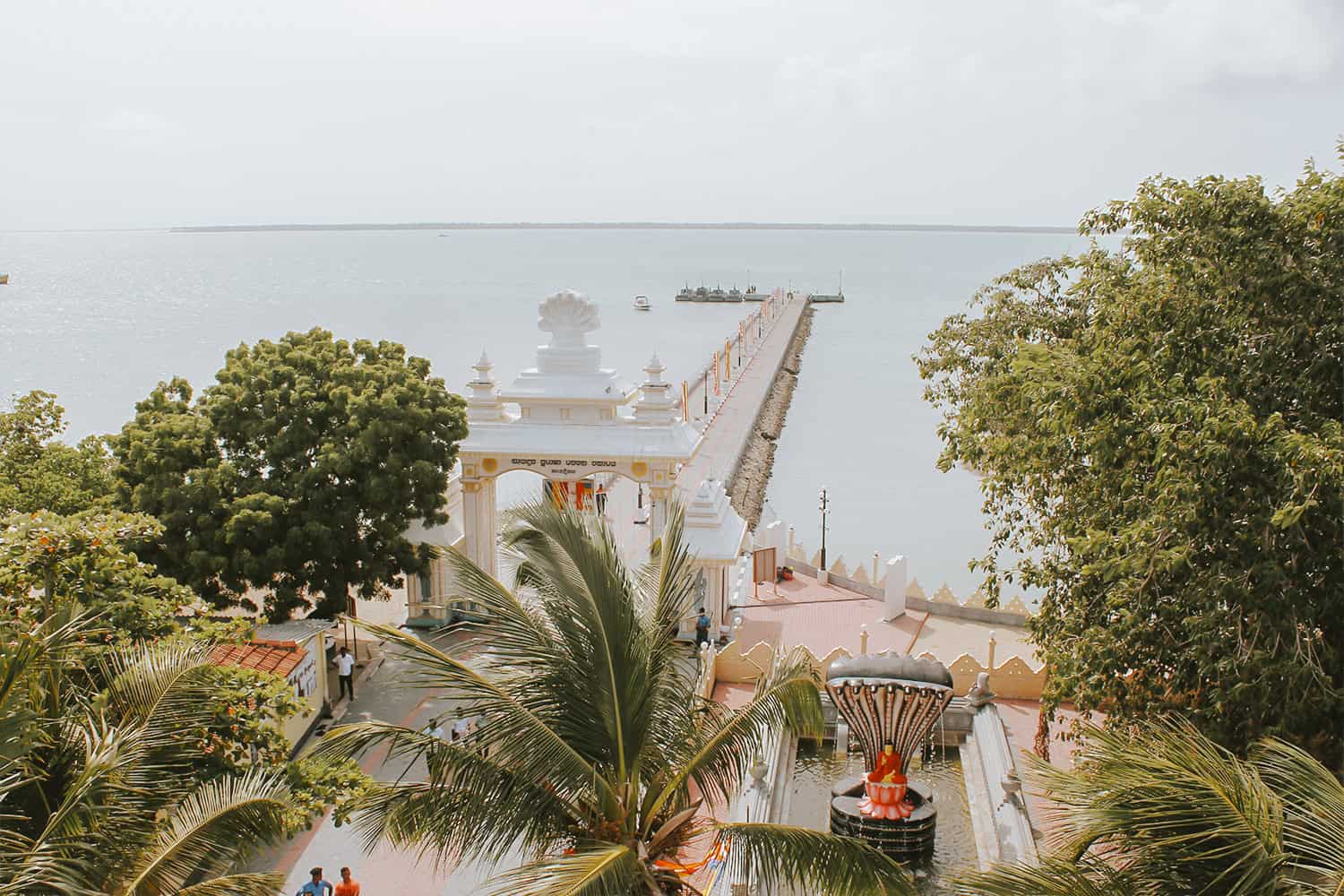
The significance of this temple is such that it is one among the 16 most sacred Sri Lankan Buddhist sites (Solosmasthana)! Yet, out of all the temples described in this article, the Nagadeepa temple is the one I have visited the least number of times; it remained inaccessible to most during Sri Lanka's 30-year civil war.
Also known as Nagadeepa in Sinhala (Naaga = snake, deepa = island), the island of Nainativu is one of the several sites in Sri Lanka believed to have been graced by Lord Buddha's presence. According to legend, in His fifth year of Enlightenment on His second visit to Sri Lanka, the Lord Buddha visited Nainativu to successfully resolve a conflict between two Naga kings over a jewel-encrusted throne. The kings Chulodhara and Mahodhara ruled the Naga people, who have been variously interpreted as a snake-worshiping tribe and a community of super-human, serpent-like beings.
The legend of the warring Naga kings who were pacified by the Buddha is included in the ancient historical chronicles titled "Mahavamsa" and also in the Tamil Buddhist epic poem "Manimekalai." In the latter, the island of Manipallavam is believed by many to be none other than modern Nainativu/ Nagadeepa.
Within the Nagadeepa temple premises, cobra-themed ornamentation is abundant and this can be seen as a tribute to the ancient Naga tribe. As you disembark from the ferry and walk towards the temple, you will notice murals of snakes on lamp posts, decorative urns and the rectangular archway that marks the temple's entrance.
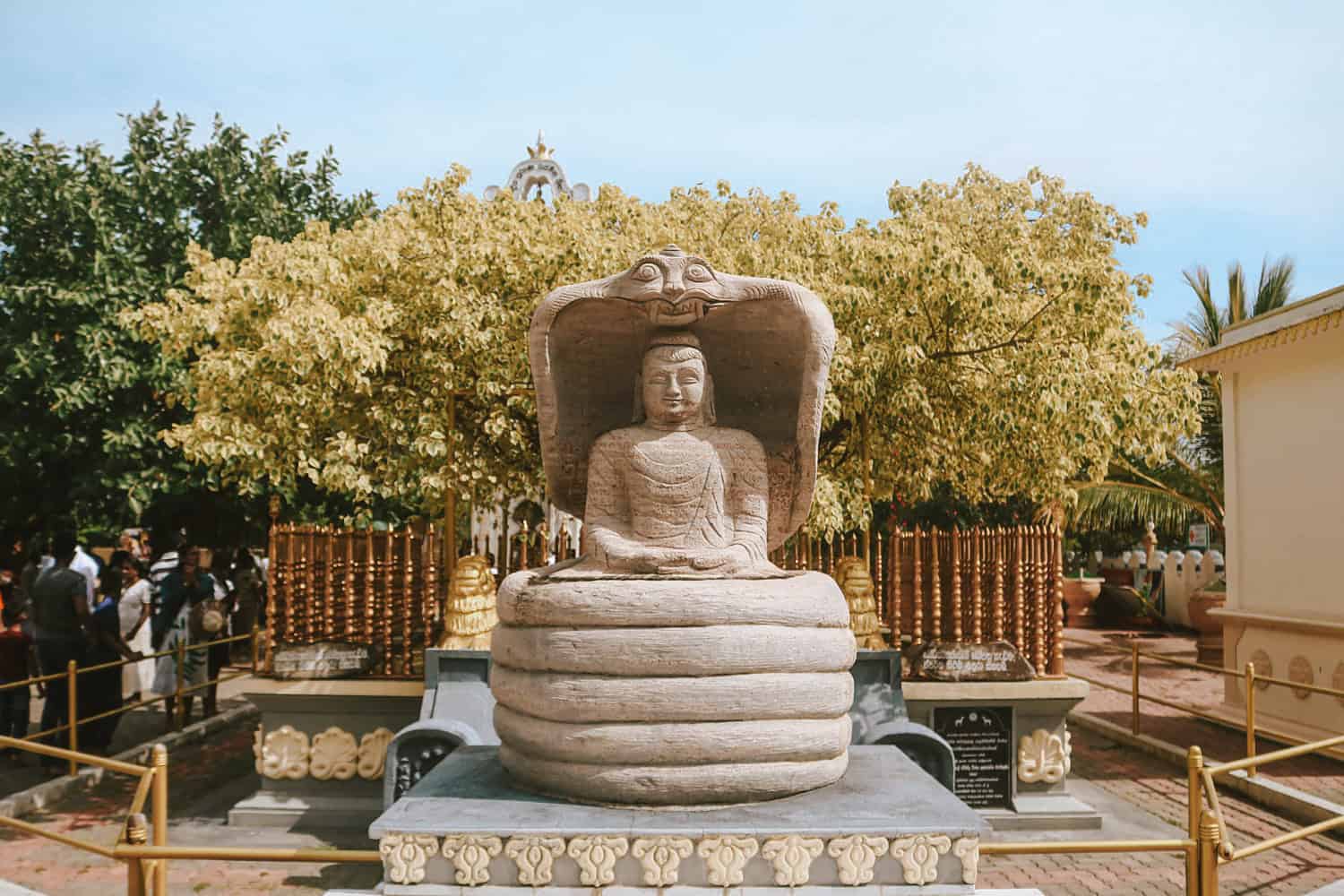
Other significant monuments within the temple are the Sudu Bodhiya (the White Bo-Tree), the silver-hued stupa surrounded by coconut trees, and a throne-like seat built to represent the jewel-studded throne which initiated the Buddha's visit to the island in the first place.
In addition, you can see a banyan tree known as the Kiripalu Nuga Ruka. Legend has it that this banyan tree was gifted by the Buddha to Chulodhara and Mahodhara who planted it on the island to memorialize the Buddha's visit to Nagadeepa.
As usual, what appealed to the history freak in me is the Nagadeepa Temple museum. On display here are items including ancient brass lamps and clay utensils unearthed from the nearby seabed, various equipment used in the temple in the recent past, and local and international currency notes and coins.
My most favourite sight in the Nagadeepa temple are the paintings of Ven. Brahmanawatte Dhammakitti Thissa and Mr. R. Ramachandran. The former was the head priest of the temple until his demise in 2003 while the latter was a Tamil Hindu who, for 60 years, had donated alms to the Nagadeepa priests! While the Nagadeepa island was honoured with the Buddha's presence, it also is representative of ethnic and religious harmony that remained intact even during a 30-year long racial conflict.
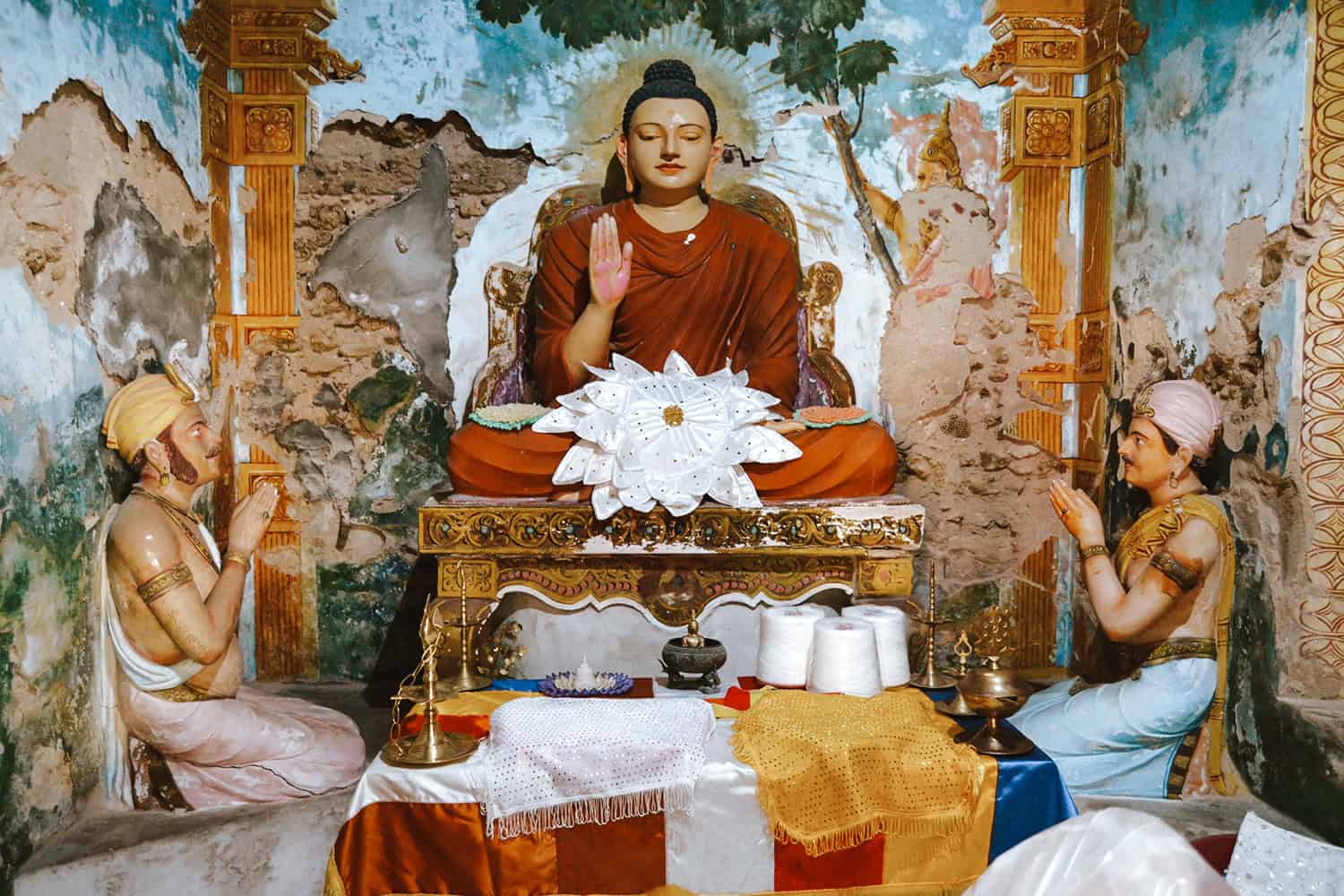
Ven. Dhammakitti was a monk from southern Sri Lanka who dedicated his ordained life to the development and maintenance of the Nagadeepa temple. Being well-versed in Tamil and English in addition to his native Sinhalese, he was respected by all people on the Nainativu island, and was influential in maintaining harmony among all races, especially between the Sinhalese and Tamils, in times of ethnic violence. A statue of this exemplary clergyman stands today in the Nagadeepa temple, in memory of the service rendered by him to the temple and all people of Nainativu.
Compared to the ancient kingdoms such as Anuradhapura and Polonnaruwa, the island of Nagadeepa does not boast of many religio-historical artifacts except for an ancient stone Buddha statue currently on display in the Buddha Walawwa Rajamaha Viharaya.
The Buddha Walawwa Rajamaha Viharaya is located around 500m away from the Nagadeepa temple on a property that was previously owned by a Tamil Hindu individual. It shelters a historic stone Mahayana Buddha statue which is interpreted as representing the moment the ascetic Gothama attained Enlightenment. After the stone statue was discovered in this area, the land was bought by the Nagadeepa temple under the guidance of Ven. Dhammakitti Thissa.
Most of what we see at the Nagadeepa temple is modern. However, the history of this temple runs many centuries into the past. It is believed that Sri Lankan kings like Dhatusena, Sadhdhatissa and Dutugemunu built and maintained temples on this island way back in the Anuradhapura period. No artifacts from the past remain however, probably due to their destruction during firstly Portuguese, Dutch and British occupation, and later due to ethnic riots within the last century.
10. The three temple loop: Gadaladeniya, Lankathilaka, Embekka of Gampola
Gadaladeniya Rajamaha Viharaya
I first visited the Gadaladeniya Temple as a child in 2001 and was overjoyed by its tranquil beauty. The lily-studded water in the rock crevices, the intricate curvaceous patterns chiseled on the pillars of this ancient stone temple, and the view of the surrounding blue-green hill country created a picture of serenity!
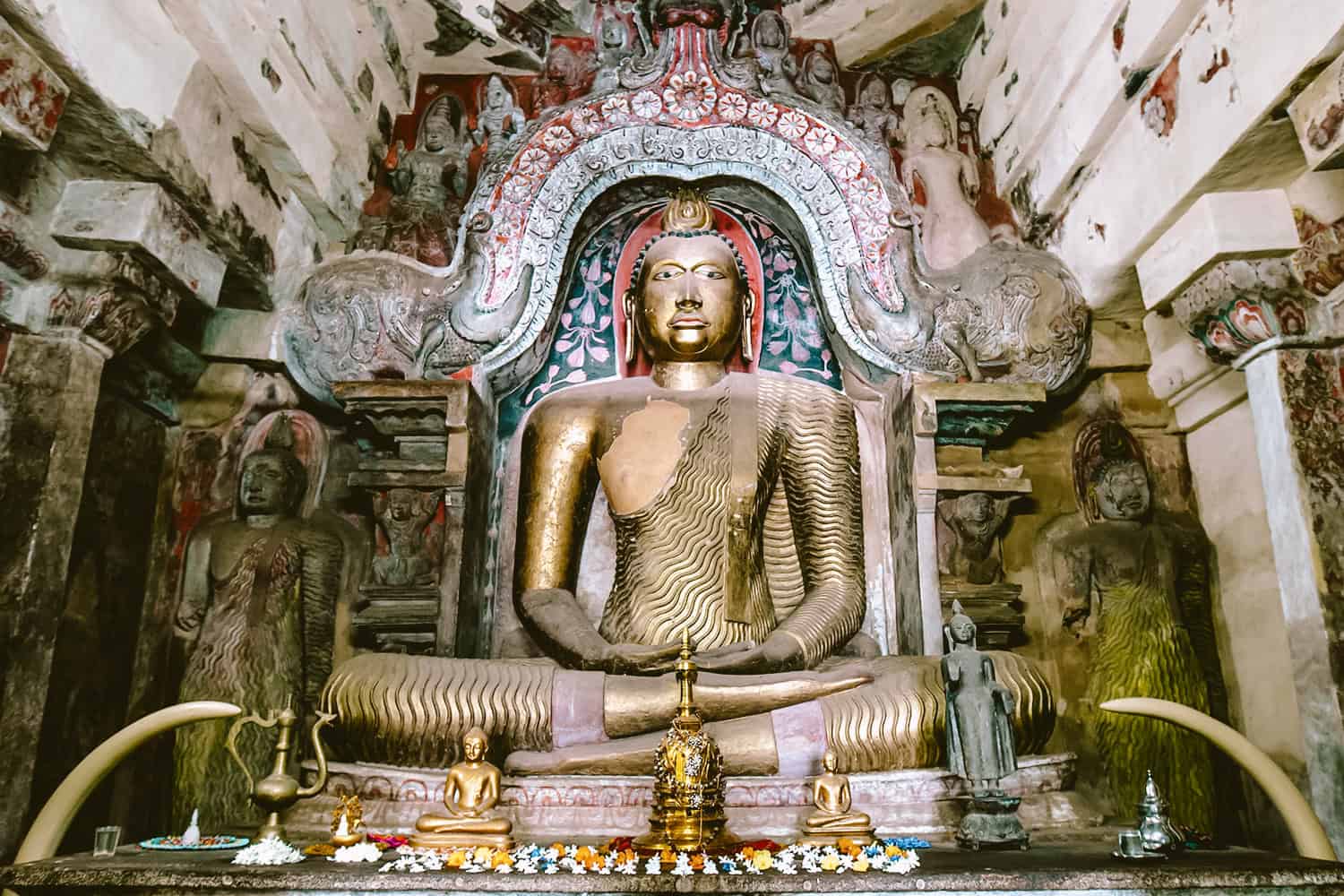
Built by King Buwenakabahu IV in the Gampola era, the Gadaladeniya Temple features a confluence of ancient South Indian and Sri Lankan architectural features. This is not surprising as, according to stone inscriptions found at Gadaladeniya, the main architect of this building was Ganeshvarachari, who was of South Indian origin.
According to the eminent Sri Lankan archaeologist, Prof. Senarat Paranavitana, the main shrine room of Gadaladeniya is crowned with two stupas to indicate it being a Buddhist religious site. The stupas replace the traditional South Indian/ Hindu shikara which is an architectural feature in the Hindu temples.
The entrance to the main shrine room is flanked by stone pillars that are adorned with stone carvings including those of Hindu deities. These columns support the granite roof of the shine which shelters one seated Buddha statue and four standing Buddhas, all adorned in gold. This massive stone edifice also contains a miniature shrine for Hindu God Vishnu. Both the main and miniature shrines are crowned with stupas. Like many other temples in Sri Lanka, new or old, Gadaladeniya too holds within itself evidence of Hindu deities and practices influencing Sri Lankan Buddhism.
Another architectural feature at Gadaladeniya is the collection of five stupas arranged on a plus-shaped stone slab several feet high. This is known as the Vijayothpaya. Out of the five stupas, the largest is at the center sheltered by a tiled roof supported on four white pillars. This construction also has four miniature Buddhist shrines in whose cool shade pilgrims make offerings of flowers to the Buddha.
Lankathilaka Rajamaha Viharaya
Another structure that bears evidence to the aesthetics of the Gampola era is the Lankathilaka Rajamaha Viharaya. Like Gadaladeniya, this majestic temple too stands on a massive rock expanse, overlooking the picture-perfect scenery of the mountainous Kandyan countryside. It was built in the reign of King Buwanekabahu IV, according to the architectural blueprints of a South Indian architect (named Sathipathi Rayar).
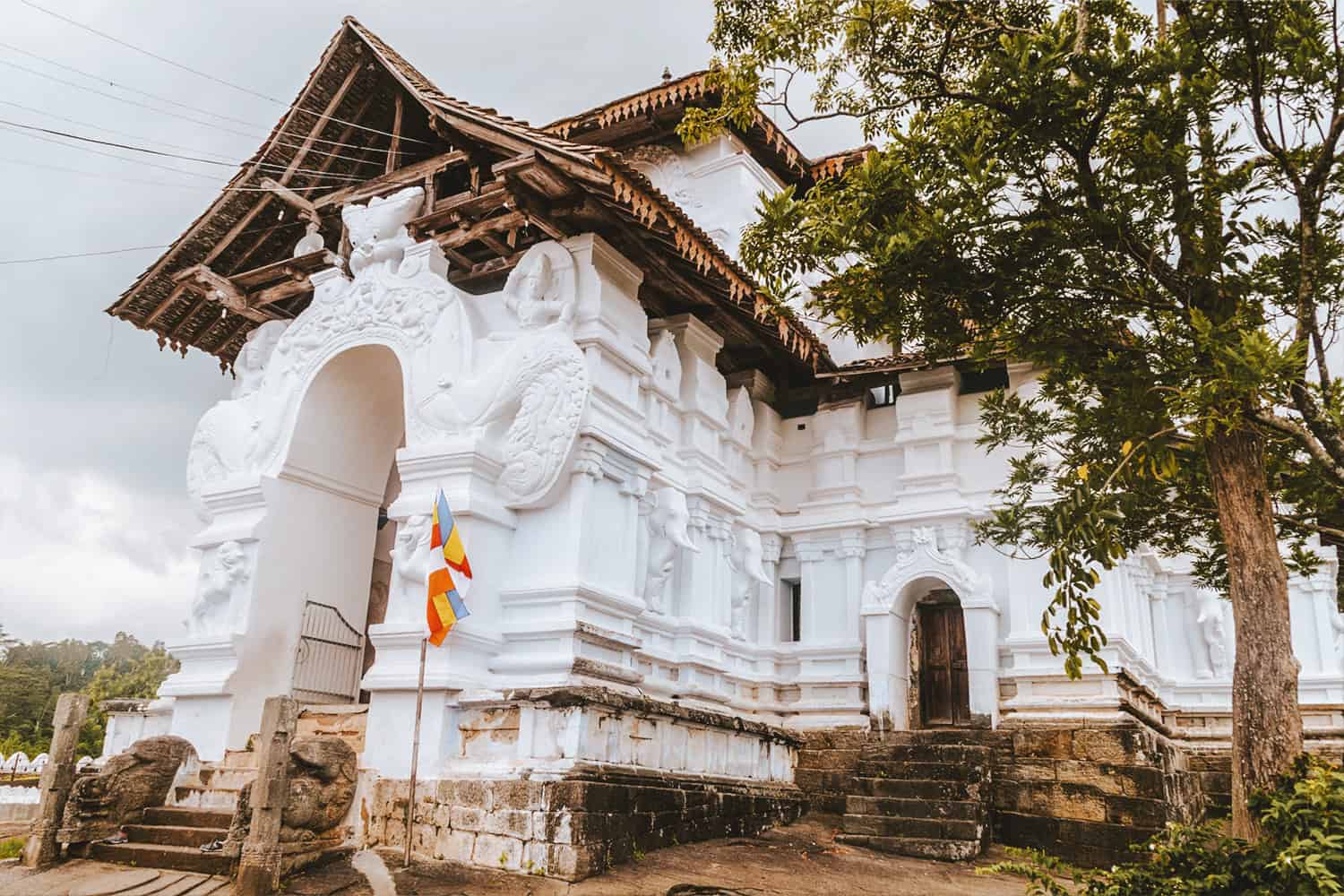
For me, Lankathilaka is more visually pleasing than Gadaladeniya as, on clear days, the whitewashed walls of this image house contrast well with the blue-green ring of mountains and the light blue skies! This is what you witness if you access the temple through its gold-coloured main gate.
The temple’s three-floored image house shelters several Buddha statues and its white walls are decorated with sculptures of lions and other details of local architecture. The insides of the image house contrast with the outer walls; they are colourful, with paintings portraying the life of the Buddha. The entrance to and the ceilings of the shrine room are decorated with murals of flowers and creepers and are testimony to the artistic talents of the Gampola era.
The bilingual rock inscription right outside the viharaya is another of my favourite features of the Lankathilaka Temple. It records in both Sinhalese and Tamil script details of various donations made to the temple, including fields, religious utensils, livestock, and even slaves! The Tamil stone inscription at Lankathilaka is the lengthiest of all stone-inscribed Tamil texts in Sri Lanka!
Do keep in mind that there are several temples named Lankathilaka. Do not mistake Lankathilaka Temple in Kandy for its namesake in Polonnaruwa!
The Embekke Temple
The Embekke Temple is a 14th-century wooden masterpiece that inspired 20th-century architects in their designing of the Independence Square in Colombo. It therefore goes without saying that the artistic talents of past Sri Lankans are exceptional and timeless!
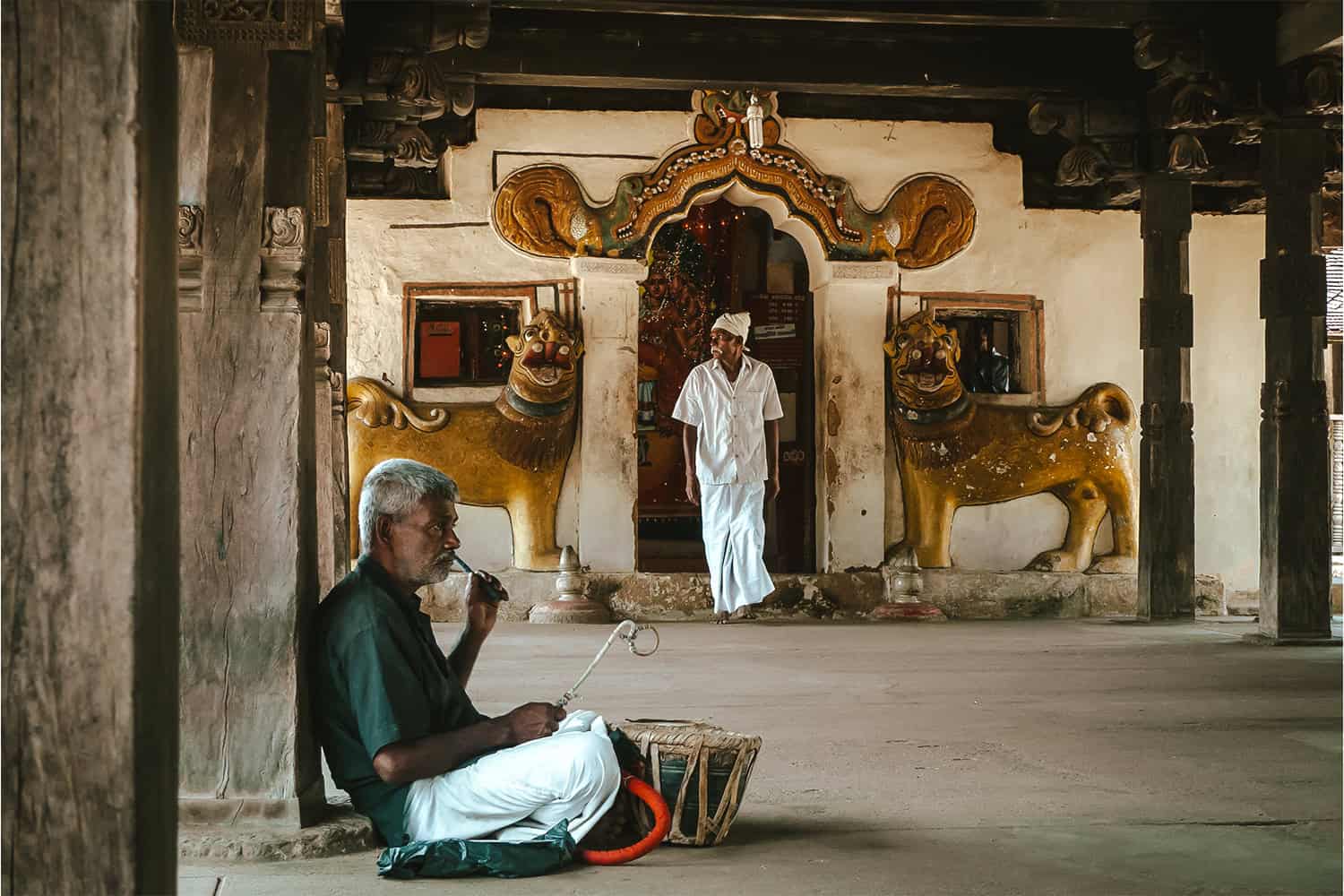
Dedicated to God Katharagama, the Embekke Temple was built in the reign of King Vickramabahu III (1357-1374).
While the main attractions of Lankathilaka and Gadaladeniya are their stone sculptures and colourful murals, at Embekka you can see wood carvings in 32 delicately chiseled wooden pillars that hold up the roof of the temple’s Drummers’ Pavilion right at the entrance to the main shrine room.
These pillars carry their own story; they are engraved with representations of mythical creatures, plants and animals and day-to-day lives of locals. For example, one inscription depicts two individuals engaged in a conversation, while another shows a mother breastfeeding a baby.
Probably the most famous of these pillar carvings is one representing two wrestlers in combat. This engraving is one of the oldest depictions of the Sri Lankan martial art, Angam Pora.
The local dance tradition named “lee keli” which uses wooden clubs too is pictured on one of the wooden pillars. This dance tradition is featured even today in the Kandy Perahera and other such temple processions in different parts of the island.
11. Kelaniya Rajamaha Viharaya: A cleanser of sins?
“All sins since birth disappear, if you worship once at Kelaniya.”
- Lokuru Naide in “Kelani Hella”
This is my translation of the final line of Naide’s 18th-century Sinhala poem which was penned in reference to the Kelaniya Temple, during the reign of Kandyan King Rajadhi Rajasinghe. Albeit exaggerated, Naide’s words show the sanctity associated with the Kelaniya Temple, which is not certainly not misplaced! Located on the banks of the Kelani River, this area was visited by the Lord Buddha Himself on His third visit to the island, 8 years after attaining Enlightenment (circa 580 BCE). This makes Kelaniya, along with Nagadeepa, closer to Sri Lankan Buddhism even more so than the kingdoms of Anuradhapura and Polonnaruwa!
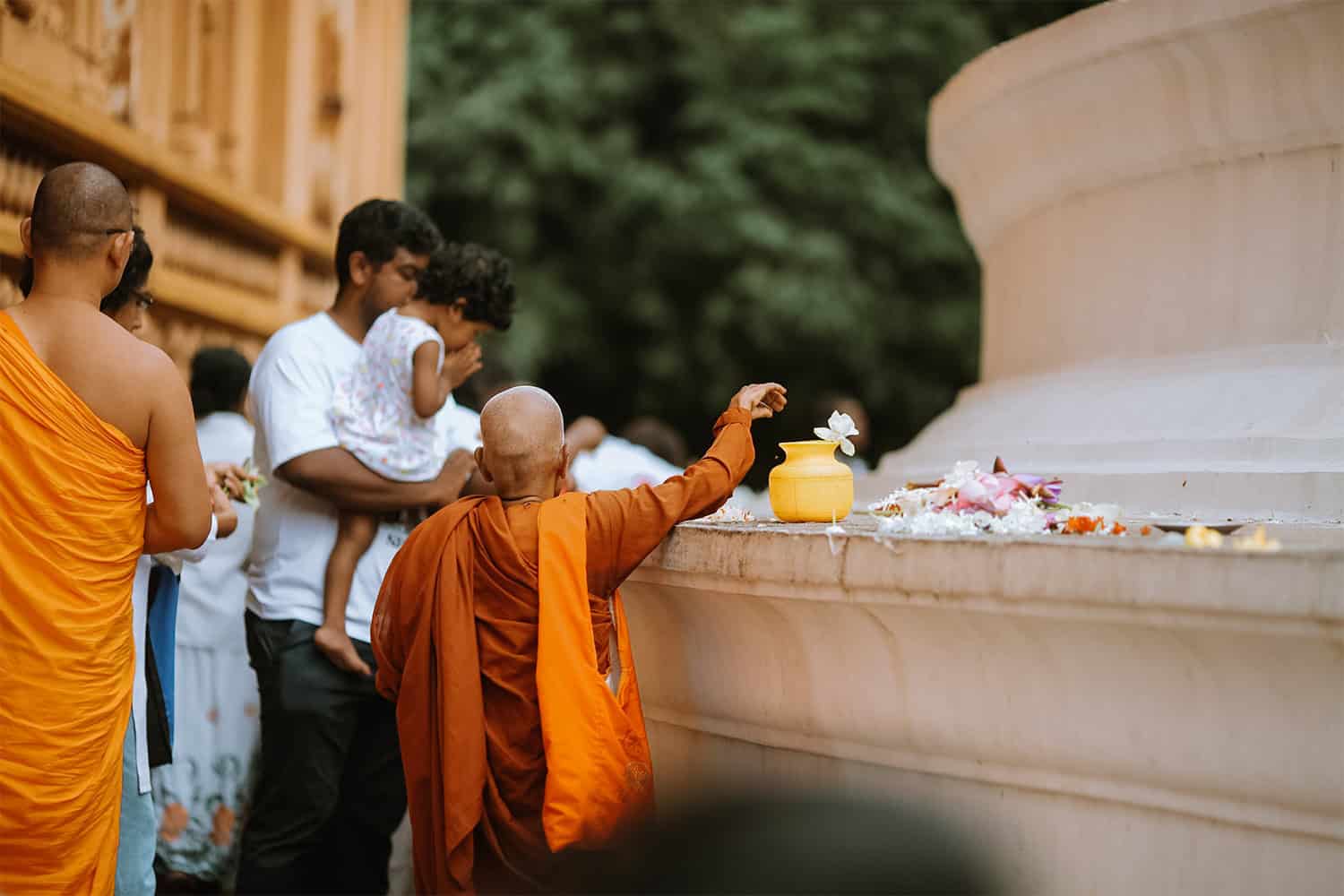
According to legend, the Naga King Maniakkitha, who was impressed by the Buddha’s preachings at Nagadeepa, invited the Buddha to Kelaniya to preach the Dhamma to the Naga community of Kelaniya. The white-hued stupa of the Kelaniya Temple is thought to have been established by the same Naga king, enshrining a jewel-encrusted chair on which the Buddha sat and preached. The stupa also supposedly marks the location the Buddha’s Dhamma sermon was held.
Like the brick and stone of Anuradhapura and Polonnaruwa, the Kelaniya Temple too has bravely withstood the tests of time for centuries. While the kingdoms of Anuradhapura and Polonnaruwa held sway in the north of the country, the Kelaniya Viharaya is said to have flourished as it received royal patronage. However, during the Chola invasions of parts of the island, the Kelaniya Temple experienced downfall, only to be restored again by the likes of King Vijayabahu III and his son King Parakramabahu II.
The Indian Chola invasions weren’t the last of the foreign influence that Kelaniya witnessed; the temple succumbed to the ravages of Portuguese occupation of the island during the Kotte era. Later, the temple was reconstructed by King Wickrama Rajasinghe.
Today, the Kelaniya Temple stands in a spacious compound surrounded with greenery. Two ornamented stone staircases leading to two pearl-white Dragon Archways mark the entrance to the temple’s main quadrangle. As you make your way from the archways, you pass a pond centered on a water fountain, and walk towards the ochre-hued Kelaniya Viharaya (Image House).
The Kelaniya Image House is an art gallery holding evidence of Sri Lankan painting and sculpting talent! It has two shrine rooms, one with old paintings and the other with a relatively modern painting style. Where the new shrine room is located is recognizable from outside as this room is crowned with an octagonal roofing structure resembling the shape of the Paththirippuwa in the Kandy Temple of the Tooth.
On the outer walls of the image house are 9 Vimanas or “abodes of gods.” These include statues embossed on the yellow wall, depicting the Lord Buddha impressing His footprint on the Sri Padhaya (Adam’s Peak) mountain. Another statue portrays God Saman, the patron deity of Sri Padhaya, looking towards the mountain. The remaining 7 Vimanas depict Maithree Bodhisatva (the god next in line to become the Buddha), King Maniakkitha, God Ganesha, Ganga Devi, God Vishnu, God Vibhishana, and Kataragama god Skandakumara.
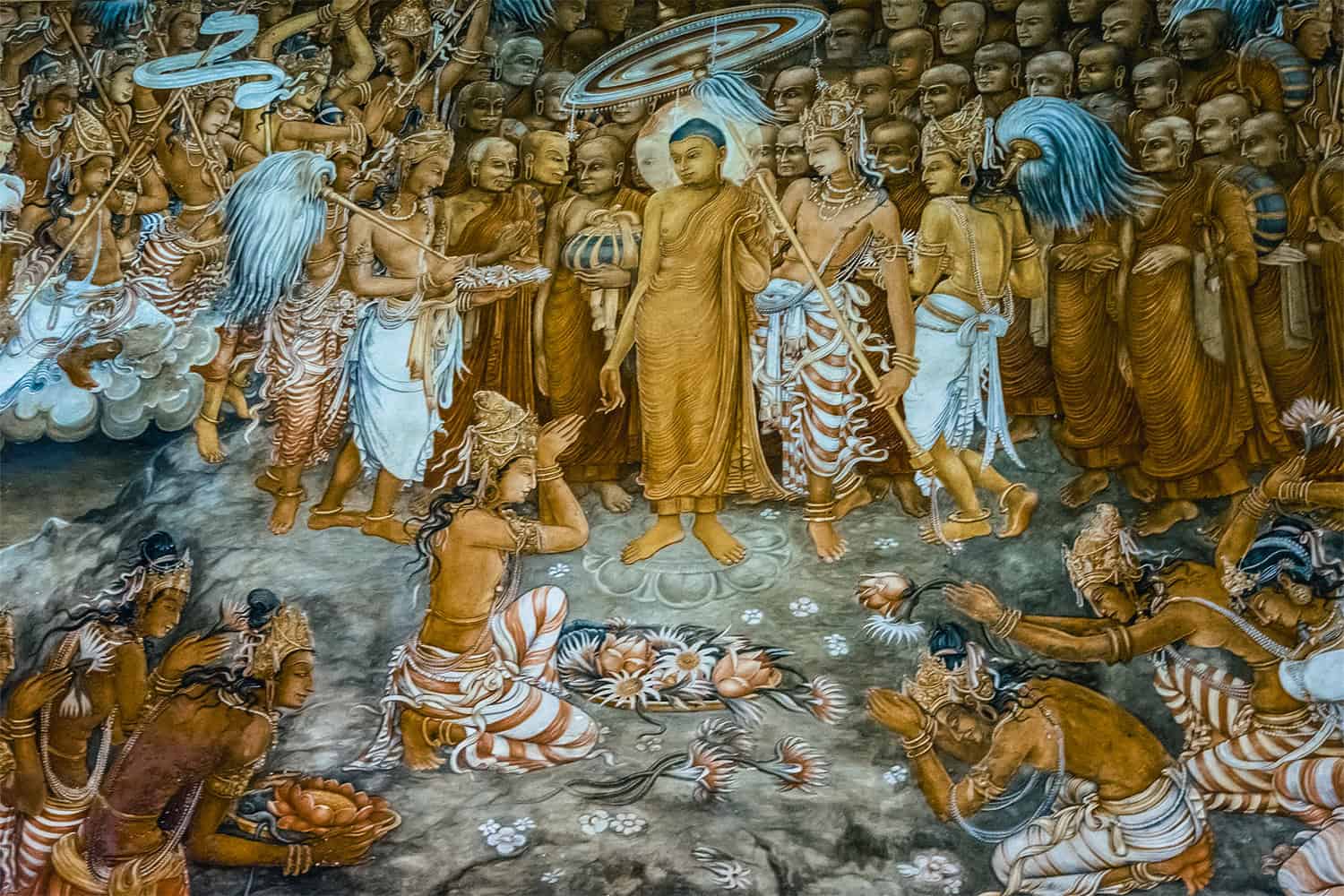
Inside the image house, you will be able to witness paintings of Jathaka stories and statues of the Buddha, King Maniakkitha, and also of Gods Natha, Saman and Skandakumara. The wall murals depict the Buddha and host of Hindu deities like the gods Hanuman, Maheshwara and Ganesha.
The paintings in the new shrine room mark a deviation from the ones that are typically found in shrine rooms of other Lankan Buddhist temples. Paintings of Jathaka Tales are absent in this shrine room; instead we witness the artistic representation of an array of historical incidents related to the introduction of Buddhism to Sri Lanka and its progress over the centuries. Some of the most memorable paintings are of the princess-turned-bhikkhuni Sangamiththa bringing to Sri Lanka a sapling of the Bo-tree under which Prince Sidhdhartha attained Enlightenment. Another painting memorializes the Prince Dantha and Princess Hemamali traversing a jungle on their journey to Sri Lanka with the Buddha’s Sacred Tooth Relic hidden in the princess’s hair.
The great Sri Lankan painter Solias Mendis is credited with beautifully and painstakingly adoring the walls of the new shrine room in the Kelaniya Viharaya. Unfortunately, the backdrop of the main statue was not painted by him; this painting departs from the colour palette and the painting style that is found on the rest of the walls, and has blue and white streaks that depict the Himalayan mountains.
Right next to the image house is the afore-described Kelaniya stupa, which is adjacent to the Kelaniya Bo Maluwa. On whichever day you visit Kelaniya, the temple is sure to be frequented by many pilgrims, primarily clad in white, chanting sacred verses and bathing the Bo-tree of the temple. This area of the temple is spacious, serene and fragrant. The rustling of the bo-leaves fall pleasantly on the ear. Shade is cast on the sand by a row of na-trees (Sri Lanka’s national tree). And, like the Buddha sought Enlightenment under the Bo-tree in Buddha Gaya many, many centuries ago, pilgrims seek spiritual shelter and solace in the shades of these trees at the Kelaniya Rajamaha Viharaya.
Summary
The story of the warring Nagadeepa kings appeased by the Buddha, the official introduction of Buddhism to Sri Lanka at the Aradhana Rock in Mihinthale, and the modern temples in the heart of Colombo all attest to the strong connection Sri Lanka bears to the Buddhist religion. The ancient and modern Buddhist temples found islandwide serve as a reminder of this, and bear testimony to the historical and religious events that shaped the evolution of Sri Lankan Buddhism. So, on your visit to Sri Lanka, do not forget to visit the history-laden and artistically pleasing Buddhist temples detailed in this article.

